Heat Transfer Augmentation through Different Jet Impingement Techniques: A State-of-the-Art Review
Abstract
1. Introduction
2. Jet Impingement Methods
2.1. Target Surface Shape and Spacing between Jet Plate/Nozzle and Target Surface
2.2. Excited Jets
2.3. Nanofluids and Phase Change Materials (PCMs)
2.3.1. Nanofluids
2.3.2. Phase Change Materials (PCMs)
3. Conclusions
Author Contributions
Funding
Conflicts of Interest
Nomenclature
| PEC | Performance evaluation criteria |
| Nu | Nusselt number for the enhanced surface |
| Nu0 | Nusselt number for the reference surface |
| Nust | Nusselt number at the stagnation point |
| St | Stanton number |
| St0 | Stanton number for the reference surface |
| f | Friction factor |
| f0 | Friction factor for the reference surface |
| Re | Reynolds number |
| PPI | Pores per inch |
| D | Inlet section diameter (m) |
| W | Heated plate side (m) |
| MIJ | Microchannel heat sink with jet impinging |
| H | Distance between jet and target surface (m) |
| D | Jet diameter (m) |
| RPM | Revolutions per minute |
| d | Dimple depth (m) |
| H | Distance between the slot jet exit and the target cylinder (m) |
| D | Diameter of circular target (m) |
| S | Slot jet width (m) |
| Hr | Rib height (m) |
| Gj | Nozzle–target plate spacing (m) |
| Dj | Jet diameter (m) |
| X | Streamwise distance/jet–jet spacing (m) |
| dpr | Relative protrusion diameter (m) |
| epr | Protrusion height (m) |
| TGR | Triangular guided rib |
| G | Nozzle–target plate spacing (m) |
| H | Confinement plate–target plate spacing (m) |
| Z | Jet–target spacing (m) |
| d | Jet diameter (m) |
| Djet | Jet diameter (m) |
| Y | Jet–jet spacing (m) |
| L | Jet–target surface distance (m) |
| y | Twist length (m) |
| Dh | Hydraulic diameter of tetra-lobed nozzle/twisted tetra-lobed nozzle (m) |
| D | Diameter of circular nozzle (m) |
| S | Swirl number |
| Dint | Injection jet inner diameter (m) |
| D | Injection jet outer diameter (m) |
| AR | Aspect ratio of lobe |
| N | Number of lobes |
| f | Actuator frequency (Hz) |
| z | Jet–plate distance (m) |
| d | Orifice diameter (m) |
| LPM | Liters per minute |
| PCM | Phase change material |
| H | Height of jet |
| W | Width of impinging jet (m) |
| NEPCM | Nano-encapsulated phase change material |
| MPCM | Micro-encapsulated phase change material |
| PAO | Polyalphaolefin |
References
- Zhou, Y.; Zheng, S.; Zhang, G. Study on the energy performance enhancement of a new PCMs integrated hybrid system with the active cooling and hybrid ventilations. Energy 2019, 179, 111–128. [Google Scholar] [CrossRef]
- Hackenhaar, W.; Mazzaferro, J.A.; Montevecchi, F.; Campatelli, G. An experimental-numerical study of active cooling in wire arc additive manufacturing. J. Manuf. Process. 2020, 52, 58–65. [Google Scholar] [CrossRef]
- Grubišić-Čabo, F.; Nižetić, S.; Marinić Kragić, I.; Čoko, D. Further progress in the research of fin-based passive cooling technique for the free-standing silicon photovoltaic panels. Int. J. Energy Res. 2019, 43, 3475–3495. [Google Scholar] [CrossRef]
- Xu, Y.; Sun, B.; Ling, Y.; Fei, Q.; Chen, Z.; Li, X.; Guo, P.; Jeon, N.; Goswami, S.; Liao, Y.; et al. Multiscale porous elastomer substrates for multifunctional on-skin electronics with passive-cooling capabilities. Proc. Natl. Acad. Sci. USA 2019, 117, 205–213. [Google Scholar] [CrossRef]
- Maghrabie, H.M.; Attalla, M.; Fawaz, H.; Khalil, M. Impingement/effusion cooling of electronic components with cross-flow. Appl. Therm. Eng. 2019, 151, 199–213. [Google Scholar] [CrossRef]
- Wiriyasart, S.; Naphon, P. Heat spreading of liquid jet impingement cooling of cold plate heat sink with different fin shapes. Case Stud. Therm. Eng. 2020, 20, 100638. [Google Scholar] [CrossRef]
- Ali, A.R.A.; Janajreh, I. Numerical Simulation of Turbine Blade Cooling via Jet Impingement. Energy Procedia 2015, 75, 3220–3229. [Google Scholar] [CrossRef][Green Version]
- Fawzy, H.; Zheng, Q.; Jiang, Y.; Lin, A.; Ahmad, N. Conjugate heat transfer of impingement cooling using conical nozzles with different schemes in a film-cooled blade leading-edge. Appl. Therm. Eng. 2020, 177, 115491. [Google Scholar] [CrossRef]
- Matheswaran, M.; Arjunan, T.; Somasundaram, D. Analytical investigation of solar air heater with jet impingement using energy and exergy analysis. Sol. Energy 2018, 161, 25–37. [Google Scholar] [CrossRef]
- Awad, M.; Radwan, A.; Abdelrehim, O.; Emam, M.; Shmroukh, A.N.; Ahmed, M. Performance evaluation of concentrator photovoltaic systems integrated with a new jet impingement-microchannel heat sink and heat spreader. Sol. Energy 2020, 199, 852–863. [Google Scholar] [CrossRef]
- Lim, H.D.; New, T.; Mariani, R.; Cui, Y. Effects of bevelled nozzles on standoff shocks in supersonic impinging jets. Aerosp. Sci. Technol. 2019, 94, 105371. [Google Scholar] [CrossRef]
- Huang, T.; Yue, L.; Chang, X. Numerical study of a fully confined supersonic slot impinging jet from bleed system. Aerosp. Sci. Technol. 2019, 90, 12–22. [Google Scholar] [CrossRef]
- Chen, K.; Xu, R.-N.; Jiang, P.-X. Experimental Investigation of Jet Impingement Cooling With Carbon Dioxide at Supercritical Pressures. J. Heat Transf. 2018, 140, 042204. [Google Scholar] [CrossRef]
- Alkhudhiri, N.M.; Gadala, M.S.; Khan, M.S. Simulation of jet impingement cooling of a stationary hot steel plate. In Proceedings of the 2020 Advances in Science and Engineering Technology International Conferences (ASET), Dubai, United Arab Emirates, 4 February–9 April 2020. [Google Scholar]
- Turkan, B.; Etemoglu, A.B.; Can, M. Analysis of evaporative drying of thin ink films using high-velocity hot-air impinging jets: A comprehensive review. Surf. Rev. Lett. 2020, 27, 1950210. [Google Scholar] [CrossRef]
- Wae-Hayee, M.; Yeranee, K.; Suksuwan, W.; Alimalbari, A.; Sae-Ung, S.; Nuntadusit, C. Heat transfer enhancement in rotary drum dryer by incorporating jet impingement to accelerate drying rate. Dry. Technol. 2020, 39, 1314–1324. [Google Scholar] [CrossRef]
- Pulat, E.; Isman, M.K.; Etemoglu, A.B.; Can, M. Effect of Turbulence Models and Near-Wall Modeling Approaches on Numerical Results in Impingement Heat Transfer. Numer. Heat Transf. Part B Fundam. 2011, 60, 486–519. [Google Scholar] [CrossRef]
- Dewan, A.; Dutta, R.; Srinivasan, B. Recent Trends in Computation of Turbulent Jet Impingement Heat Transfer. Heat Transf. Eng. 2012, 33, 447–460. [Google Scholar] [CrossRef]
- Dutta, R.; Dewan, A.; Srinivasan, B. Comparison of various integration to wall (ITW) RANS models for predicting turbulent slot jet impingement heat transfer. Int. J. Heat Mass Transf. 2013, 65, 750–764. [Google Scholar] [CrossRef]
- Jambunathan, K.; Lai, E.; Moss, M.; Button, B. A review of heat transfer data for single circular jet impingement. Int. J. Heat Fluid Flow 1992, 13, 106–115. [Google Scholar] [CrossRef]
- Viskanta, R. Heat transfer to impinging isothermal gas and flame jets. Exp. Therm. Fluid Sci. 1993, 6, 111–134. [Google Scholar] [CrossRef]
- Han, B.; Goldstein, J. Jet-Impingement Heat Transfer in Gas Turbine System. Heat Transf. Gas Turbine Syst. 2006, 934, 147–161. [Google Scholar] [CrossRef]
- Patil, N.G.; Tapano, K.H. A review on cooling of discrete heated modules using liquid jet impingement. Front. Heat Mass Transf. 2018, 16. [Google Scholar]
- Krishan, G.; Aw, K.C.; Sharma, R.N. Synthetic jet impingement heat transfer enhancement—A review. Appl. Therm. Eng. 2019, 149, 1305–1323. [Google Scholar] [CrossRef]
- Mohammadpour, J.; Lee, A. Investigation of nanoparticle effects on jet impingement heat transfer: A review. J. Mol. Liq. 2020, 316, 113819. [Google Scholar] [CrossRef]
- Xie, R.; Wang, H.; Xu, B.; Wang, W. A Review of Impingement Jet Cooling in Combustor Liner. In Proceedings of the ASME Turbo Expo 2018: Turbomachinery Technical Conference and Exposition, Oslo, Norway, 11–15 June 2018. [Google Scholar] [CrossRef]
- Chirade, S.; Ingole, S.; Sundaram, K.K. Review of Correlations on Jet Impingement Cooling. Int. J. Sci. Res. 2015, 4, 3107–3111. [Google Scholar]
- Qiu, L.; Dubey, S.; Choo, F.H.; Duan, F. Recent developments of jet impingement nucleate boiling. Int. J. Heat Mass Transf. 2015, 89, 42–58. [Google Scholar] [CrossRef]
- Marazani, T.; Madyira, D.M.; Akinlabi, E.T. Investigation of the Parameters Governing the Performance of Jet Impingement Quick Food Freezing and Cooling Systems—A Review. Procedia Manuf. 2017, 8, 754–760. [Google Scholar] [CrossRef]
- Darwish, A.M.; El-kersh, A.M.R.; El-sheikh, M.N.; El-moghazy, M. A Review on Nanofluid Impingement Jet Heat Transfer. Int. J. Nanotechnol. Allied Sci. 2017, 1, 1–15. [Google Scholar]
- Agrawal, C. Surface Quenching by Jet Impingement—A Review. Steel Res. Int. 2018, 1800285, 1–22. [Google Scholar] [CrossRef]
- Choi, E.Y.; Choi, Y.D.; Lee, W.S.; Chung, J.T.; Kwak, J.S. Heat transfer augmentation using a rib–dimple compound cooling technique. Appl. Therm. Eng. 2013, 51, 435–441. [Google Scholar] [CrossRef]
- Webb, R.; Eckert, E. Application of rough surfaces to heat exchanger design. Int. J. Heat Mass Transf. 1972, 15, 1647–1658. [Google Scholar] [CrossRef]
- Yilmaz, M.; Comakli, O.; Yapici, S.; Sara, O.N.; Yılmaz, M.; Yapıcı, S. Performance Evaluation Criteria for Heat Exchangers Based on First Law Analysis. J. Enhanc. Heat Transf. 2005, 12, 121–158. [Google Scholar] [CrossRef]
- Iasiello, M.; Bianco, N.; Chiu, W.K.; Naso, V. The effects of variable porosity and cell size on the thermal performance of functionally-graded foams. Int. J. Therm. Sci. 2020, 160, 106696. [Google Scholar] [CrossRef]
- Yang, S.; Zhao, Z.; Zhang, Y.; Chen, Z.; Yang, M. Effects of Fin Arrangements on Thermal Hydraulic Performance of Supercritical Nitrogen in Printed Circuit Heat Exchanger. Processes 2021, 9, 861. [Google Scholar] [CrossRef]
- Setareh, M.; Saffar-Avval, M.; Abdullah, A. Experimental and numerical study on heat transfer enhancement using ultrasonic vibration in a double-pipe heat exchanger. Appl. Therm. Eng. 2019, 159, 113867. [Google Scholar] [CrossRef]
- Sabir, R.; Khan, M.M.; Sheikh, N.A.; Ahad, I.U.; Brabazon, D. Assessment of thermo-hydraulic performance of inward dimpled tubes with variation in angular orientations. Appl. Therm. Eng. 2020, 170, 115040. [Google Scholar] [CrossRef]
- Feng, S.; Kuang, J.; Wen, T.; Lu, T.; Ichimiya, K. An experimental and numerical study of finned metal foam heat sinks under impinging air jet cooling. Int. J. Heat Mass Transf. 2014, 77, 1063–1074. [Google Scholar] [CrossRef]
- Feng, S.S.; Kuang, J.J.; Lu, T.J.; Ichimiya, K. Heat Transfer and Pressure Drop Characteristics of Finned Metal Foam Heat Sinks Under Uniform Impinging Flow. J. Electron. Packag. 2015, 137, 021014. [Google Scholar] [CrossRef]
- Andreozzi, A.; Bianco, N.; Iasiello, M.; Naso, V. Numerical study of metal foam heat sinks under uniform impinging flow. J. Phys. Conf. Ser. 2017, 796, 012002. [Google Scholar] [CrossRef]
- Bianco, N.; Iasiello, M.; Mauro, G.M.; Pagano, L. Multi-objective optimization of finned metal foam heat sinks: Tradeoff between heat transfer and pressure drop. Appl. Therm. Eng. 2020, 182, 116058. [Google Scholar] [CrossRef]
- Wan, C.; Rao, Y.; Chen, P. Numerical predictions of jet impingement heat transfer on square pin-fin roughened plates. Appl. Therm. Eng. 2015, 80, 301–309. [Google Scholar] [CrossRef]
- Huang, X.; Yang, W.; Ming, T.; Shen, W.; Yu, X. Heat transfer enhancement on a microchannel heat sink with impinging jets and dimples. Int. J. Heat Mass Transf. 2017, 112, 113–124. [Google Scholar] [CrossRef]
- Jing, Q.; Zhang, D.; Xie, Y. Numerical investigations of impingement cooling performance on flat and non-flat targets with dimple/protrusion and triangular rib. Int. J. Heat Mass Transf. 2018, 126, 169–190. [Google Scholar] [CrossRef]
- Nagesha, K.; Srinivasan, K.; Sundararajan, T. Enhancement of jet impingement heat transfer using surface roughness elements at different heat inputs. Exp. Therm. Fluid Sci. 2019, 112, 109995. [Google Scholar] [CrossRef]
- Xu, L.; Zhao, X.; Xi, L.; Ma, Y.; Gao, J.; Li, Y. Large-Eddy Simulation Study of Flow and Heat Transfer in Swirling and Non-Swirling Impinging Jets on a Semi-Cylinder Concave Target. Appl. Sci. 2021, 11, 7167. [Google Scholar] [CrossRef]
- McInturff, P.; Suzuki, M.; Ligrani, P.; Nakamata, C.; Lee, D.H. Effects of hole shape on impingement jet array heat transfer with small-scale, target surface triangle roughness. Int. J. Heat Mass Transf. 2018, 127, 585–597. [Google Scholar] [CrossRef]
- Singh, P.; Ekkad, S. Experimental study of heat transfer augmentation in a two-pass channel featuring V-shaped ribs and cylindrical dimples. Appl. Therm. Eng. 2017, 116, 205–216. [Google Scholar] [CrossRef]
- Singh, P.; Ekkad, S.V. Detailed Heat Transfer Measurements of Jet Impingement on Dimpled Target Surface Under Rotation. J. Therm. Sci. Eng. Appl. 2018, 10, 031006. [Google Scholar] [CrossRef]
- Vinze, R.; Khade, A.; Kuntikana, P.; Ravitej, M.; Suresh, B.; Kesavan, V.; Prabhu, S. Effect of dimple pitch and depth on jet impingement heat transfer over dimpled surface impinged by multiple jets. Int. J. Therm. Sci. 2019, 145, 105974. [Google Scholar] [CrossRef]
- Singh, A.; Prasad, B. Influence of novel equilaterally staggered jet impingement over a concave surface at fixed pumping power. Appl. Therm. Eng. 2018, 148, 609–619. [Google Scholar] [CrossRef]
- Jordan, C.N.; Wright, L.M.; Crites, D.C. Impingement heat transfer on a cylindrical, concave surface with varying jet geometries. J. Heat Transf. 2016, 138, 1–10. [Google Scholar] [CrossRef]
- Qiu, D.; Wang, C.; Luo, L.; Wang, S.; Zhao, Z.; Wang, Z. On heat transfer and flow characteristics of jets impinging onto a concave surface with varying jet arrangements. J. Therm. Anal. Calorim. 2019, 141, 57–68. [Google Scholar] [CrossRef]
- Takeishi, K.-I.; Krewinkel, R.; Oda, Y.; Ichikawa, Y. Heat Transfer Enhancement of Impingement Cooling by Adopting Circular-Ribs or Vortex Generators in the Wall Jet Region of a Round Impingement Jet. Int. J. Turbomach. Propuls. Power 2020, 5, 17. [Google Scholar] [CrossRef]
- Pachpute, S.; Premachandran, B. Slot air jet impingement cooling over a heated circular cylinder with and without a flow confinement. Appl. Therm. Eng. 2018, 132, 352–367. [Google Scholar] [CrossRef]
- Pachpute, S.; Premachandran, B. Turbulent multi-jet impingement cooling of a heated circular cylinder. Int. J. Therm. Sci. 2019, 148, 106167. [Google Scholar] [CrossRef]
- Tepe, A.; Arslan, K.; Yetisken, Y.; Uysal, U. Effects of Extended Jet Holes to Heat Transfer and Flow Characteristics of the Jet Impingement Cooling. J. Heat Transf. 2019, 141, 082202. [Google Scholar] [CrossRef]
- Tepe, A.U.; Uysal, A.; Yetişken, Y.; Arslan, K. Jet impingement cooling on a rib-roughened surface using extended jet holes. Appl. Therm. Eng. 2020, 178, 115601. [Google Scholar] [CrossRef]
- Tong, F.; Gou, W.; Zhao, Z.; Gao, W.; Li, H.; Li, L. Numerical investigation of impingement heat transfer on smooth and roughened surfaces in a high-pressure turbine inner casing. Int. J. Therm. Sci. 2019, 149, 106186. [Google Scholar] [CrossRef]
- Singh, S.; Chaurasiya, S.K.; Negi, B.S.; Chander, S.; Nemś, M.; Negi, S. Utilizing circular jet impingement to enhance thermal performance of solar air heater. Renew. Energy 2020, 154, 1327–1345. [Google Scholar] [CrossRef]
- Maithani, R.; Kumar, A.; Raghav, G.; Nagpal, M.; Kumar, B. Thermal analysis of jet impingement on hemispherical protrusion on heated surface. Exp. Heat Transf. 2020, 1–16. [Google Scholar] [CrossRef]
- Hadipour, A.; Zargarabadi, M.R.; Mohammadpour, J. Effects of a triangular guide rib on flow and heat transfer in a turbulent jet impingement on an asymmetric concave surface. Phys. Fluids 2020, 32, 075112. [Google Scholar] [CrossRef]
- Tepe, A.U. Numerical investigation of a novel jet hole design for staggered array jet impingement cooling on a semicircular concave surface. Int. J. Therm. Sci. 2020, 162, 106792. [Google Scholar] [CrossRef]
- Lytle, D.; Webb, B. Air jet impingement heat transfer at low nozzle-plate spacings. Int. J. Heat Mass Transf. 1994, 37, 1687–1697. [Google Scholar] [CrossRef]
- Lee, J.; Ren, Z.; Ligrani, P.; Fox, M.D.; Moon, H. International Journal of Thermal Sciences Cross flows from jet array impingement cooling: Hole spacing, target plate distance, Reynolds number effects. Int. J. Therm. Sci. 2015, 88, 7–18. [Google Scholar] [CrossRef]
- Madhavan, S.; Singh, P.; Ekkad, S.V. Jet Impingement Heat Transfer Enhancement by Packing High-Porosity Thin Metal Foams Between Jet Exit Plane and Target Surface. J. Therm. Sci. Eng. Appl. 2019, 11, 1–22. [Google Scholar] [CrossRef]
- Tepe, A.U.; Yetişken, Y.; Uysal, U.; Arslan, K. Experimental and numerical investigation of jet impingement cooling using extended jet holes. Int. J. Heat Mass Transf. 2020, 158, 119945. [Google Scholar] [CrossRef]
- Gao, F.; Chen, Y.; Cai, J.; Ma, C. Experimental study of free-surface jet impingement heat transfer with molten salt. Int. J. Heat Mass Transf. 2019, 149, 119160. [Google Scholar] [CrossRef]
- Ji, W.-T.; Lu, X.-D.; Chen, L.; Zhang, Y.-W.; Tao, W.-Q. Experimental investigation on the ice melting heat transfer with a steam jet impingement method. Int. Commun. Heat Mass Transf. 2020, 118, 104901. [Google Scholar] [CrossRef]
- Siddique, U.; Ansari, E.; Khan, S.A.; Patil, R. Numerical Investigation of Secondary Peaks in Nusselt Profile Under Water Jet Impingement. J. Thermophys. Heat Transf. 2020, 34, 421–428. [Google Scholar] [CrossRef]
- Yadav, S.; Saini, R. Numerical investigation on the performance of a solar air heater using jet impingement with absorber plate. Sol. Energy 2020, 208, 236–248. [Google Scholar] [CrossRef]
- Baghel, K.; Sridharan, A.; Murallidharan, J.S. Experimental and numerical study of inclined free surface liquid jet impingement. Int. J. Therm. Sci. 2020, 154, 106389. [Google Scholar] [CrossRef]
- Pratap, A.; Baghel, Y.; Patel, V.K. Effect of impingement height on the enhancement of heat transfer with circular confined jet impingement using nanofluids. Mater. Today Proc. 2020, 28, 1656–1661. [Google Scholar] [CrossRef]
- Forster, M.; Weigand, B. Experimental and numerical investigation of jet impingement cooling onto a concave leading edge of a generic gas turbine blade. Int. J. Therm. Sci. 2021, 164, 106862. [Google Scholar] [CrossRef]
- Alhajeri, H.M.; Almutairi, A.; Alenezi, A.; Gamil, A.A.; Al-Hajeri, M. Effect of mist/steam uniformity on heat transfer characteristics in unconfined jet impingement. Appl. Therm. Eng. 2020, 186, 116299. [Google Scholar] [CrossRef]
- Zhang, D.; Qu, H.; Lan, J.; Chen, J.; Xie, Y. Flow and heat transfer characteristics of single jet impinging on protrusioned surface. Int. J. Heat Mass Transf. 2013, 58, 18–28. [Google Scholar] [CrossRef]
- Selimefendigil, F.; Öztop, H.F. Jet impingement cooling and optimization study for a partly curved isothermal surface with CuO-water nano fluid. Int. Commun. Heat Mass Transf. 2017, 89, 211–218. [Google Scholar] [CrossRef]
- Wongcharee, K.; Chuwattanakul, V.; Eiamsa-Ard, S. Influence of CuO/water nanofluid concentration and swirling flow on jet impingement cooling. Int. Commun. Heat Mass Transf. 2017, 88, 277–283. [Google Scholar] [CrossRef]
- Feng, X.; Cousineau, E.; Bennion, K.; Moreno, G.; Kekelia, B.; Narumanchi, S. Experimental and numerical study of heat transfer characteristics of single-phase free-surface fan jet impingement with automatic transmission fluid. Int. J. Heat Mass Transf. 2020, 166, 120731. [Google Scholar] [CrossRef]
- Sundaram, R.D.; Madhavan, S.; Singh, P.; Ekkad, S.V. Enhanced fin-effectiveness of micro-scale concentric-shape roughened target surface subjected to array jet impingement. Int. J. Heat Mass Transf. 2021, 173, 121148. [Google Scholar] [CrossRef]
- Sagot, B.; Antonini, G.; Christgen, A.; Buron, F. Jet impingement heat transfer on a flat plate at a constant wall temperature. Int. J. Therm. Sci. 2008, 47, 1610–1619. [Google Scholar] [CrossRef]
- Li, W.; Li, X.; Yang, L.; Ren, J.; Jiang, H.; Ligrani, P. Effect of Reynolds number, hole patterns, and hole inclination on cooling performance of an impinging jet array-part I: Convective heat transfer results and optimization. J. Turbomach. 2017, 139, 1–11. [Google Scholar] [CrossRef]
- Ansu, U.; Godi, S.C.; Pattamatta, A.; Balaji, C. Experimental investigation of the inlet condition on jet impingement heat transfer using liquid crystal thermography. Exp. Therm. Fluid Sci. 2017, 80, 363–375. [Google Scholar] [CrossRef]
- Greco, C.S.; Paolillo, G.; Ianiro, A.; Cardone, G.; de Luca, L. Effects of the stroke length and nozzle-to-plate distance on synthetic jet impingement heat transfer. Int. J. Heat Mass Transf. 2018, 117, 1019–1031. [Google Scholar] [CrossRef]
- Glaspell, A.W.; Rouse, V.J.; Friedrich, B.K.; Choo, K. Heat transfer and hydrodynamics of air assisted free water jet impingement at low nozzle-to-surface distances. Int. J. Heat Mass Transf. 2018, 132, 138–142. [Google Scholar] [CrossRef]
- Markal, B.; Avci, M.; Aydin, O. Conical coaxial impinging air jets: Angle effect on the heat transfer performance. Heat Mass Transf. 2020, 56, 3135–3146. [Google Scholar] [CrossRef]
- Chen, L.; Brakmann, R.G.; Weigand, B.; Poser, R. An experimental heat transfer investigation of an impingement jet array with turbulators on both target plate and impingement plate. Appl. Therm. Eng. 2020, 166, 114661. [Google Scholar] [CrossRef]
- Maghrabie, H.M. Heat transfer intensification of jet impingement using exciting jets—A comprehensive review. Renew. Sustain. Energy Rev. 2021, 139, 110684. [Google Scholar] [CrossRef]
- Xu, L.; Xiong, Y.; Xi, L.; Gao, J.; Li, Y.; Zhao, Z. Numerical Simulation of Swirling Impinging Jet Issuing from a Threaded Hole under Inclined Condition. Entropy 2019, 22, 15. [Google Scholar] [CrossRef]
- Wongcharee, K.; Kunnarak, K.; Chuwattanakul, V.; Eiamsa-Ard, S. Heat transfer rate of swirling impinging jets issuing from a twisted tetra-lobed nozzle. Case Stud. Therm. Eng. 2020, 22, 100780. [Google Scholar] [CrossRef]
- Ikhlaq, M.; Al-Abdeli, Y.M.; Khiadani, M. Nozzle exit conditions and the heat transfer in non-swirling and weakly swirling turbulent impinging jets. Heat Mass Transf. 2019, 56, 269–290. [Google Scholar] [CrossRef]
- Debnath, S.; Khan, H.U.; Ahmed, Z.U. Turbulent swirling impinging jet arrays: A numerical study on fluid flow and heat transfer. Therm. Sci. Eng. Prog. 2020, 19, 100580. [Google Scholar] [CrossRef]
- Sapra, G.; Chander, S. Effect of operating and geometrical parameters of tangential entry type dual swirling flame burner on impingement heat transfer. Appl. Therm. Eng. 2020, 181, 115936. [Google Scholar] [CrossRef]
- Chang, S.W.; Shen, H.-D. Heat transfer characteristics of swirling impinging jet-arrays issued from nozzle plates with and without webbed grooves. Int. J. Therm. Sci. 2019, 148, 106155. [Google Scholar] [CrossRef]
- Chang, S.; Hsieh, M.-F.; Cai, W.-L.; Shen, H.-D. Detailed heat transfer measurements of impinging swirling and non-swirling jet arrays emitted from grooved orifice plate. Chem. Eng. Process. Process. Intensif. 2020, 149, 107820. [Google Scholar] [CrossRef]
- Fawzy, H.; Zheng, Q.; Ahmad, N.; Jiang, Y. Optimization of A Swirl with Impingement Compound Cooling Unit for A Gas Turbine Blade Leading Edge. Energies 2020, 13, 210. [Google Scholar] [CrossRef]
- Fawzy, H.; Zheng, Q.; Ahmad, N. Effect of Slot Area Ratio and Slot Angle on Swirl Cooling in a Gas Turbine Blade Leading Edge. J. Aerosp. Eng. 2020, 33, 04020046. [Google Scholar] [CrossRef]
- Park, T.; Kara, K.; Kim, D. Flow structure and heat transfer of a sweeping jet impinging on a flat wall. Int. J. Heat Mass Transf. 2018, 124, 920–928. [Google Scholar] [CrossRef]
- Zhou, W.; Yuan, L.; Liu, Y.; Peng, D.; Wen, X. Heat transfer of a sweeping jet impinging at narrow spacings. Exp. Therm. Fluid Sci. 2019, 103, 89–98. [Google Scholar] [CrossRef]
- Wen, X.; Liu, J.; Li, Z.; Peng, D.; Zhou, W.; Kim, K.C.; Liu, Y. Jet impingement using an adjustable spreading-angle sweeping jet. Aerosp. Sci. Technol. 2020, 105, 105956. [Google Scholar] [CrossRef]
- Kim, M.; Kim, D.; Yeom, E.; Kim, K.C. Experimental study on heat transfer and flow structures of feedback-free sweeping jet impinging on a flat surface. Int. J. Heat Mass Transf. 2020, 159, 120085. [Google Scholar] [CrossRef]
- Afroz, F.; Sharif, M.A. Numerical investigation of heat transfer from a plane surface due to turbulent annular swirling jet impingement. Int. J. Therm. Sci. 2020, 151, 106257. [Google Scholar] [CrossRef]
- Dutta, P.; Chattopadhyay, H. Computational analysis of heat transfer due to turbulent annular jet impingement. IOP Conf. Ser. Mater. Sci. Eng. 2021, 1080, 012031. [Google Scholar] [CrossRef]
- Fénot, M.; Dorignac, E.; Lantier, R. Heat transfer and flow structure of a hot annular impinging jet. Int. J. Therm. Sci. 2021, 170, 107091. [Google Scholar] [CrossRef]
- Huang, L.; Yeom, T.; Simon, T.; Cui, T. An experimental and numerical study on heat transfer enhancement of a heat sink fin by synthetic jet impingement. Heat Mass Transf. 2020, 57, 583–593. [Google Scholar] [CrossRef]
- Singh, P.K.; Sahu, S.K.; Upadhyay, P.K.; Jain, A.K. Experimental investigation on thermal characteristics of hot surface by synthetic jet impingement. Appl. Therm. Eng. 2019, 165, 114596. [Google Scholar] [CrossRef]
- Travnicek, Z.; Antosova, Z. Impingement heat transfer to the synthetic jet issuing from a nozzle with an oscillating cross section. Int. J. Therm. Sci. 2020, 153, 106349. [Google Scholar] [CrossRef]
- Singh, P.K.; Sahu, S.K.; Upadhyay, P.K. Experimental investigation of the thermal behavior a single-cavity and multiple-orifice synthetic jet impingement driven by electromagnetic actuator for electronics cooling. Exp. Heat Transf. 2020, 1–27. [Google Scholar] [CrossRef]
- Lyu, Y.-W.; Zhang, J.-Z.; Tang, C.; Tan, X.-M. Temperature-variation effect of piston-driven synthetic jet and its influence on definition of heat transfer coefficient. Int. J. Heat Mass Transf. 2020, 152, 119347. [Google Scholar] [CrossRef]
- Gil, P.; Wilk, J. Heat transfer coefficients during the impingement cooling with the use of synthetic jet. Int. J. Therm. Sci. 2019, 147, 106132. [Google Scholar] [CrossRef]
- Gil, P.; Wilk, J.; Smusz, R.; Gałek, R. Centerline heat transfer coefficient distributions of synthetic jets impingement cooling. Int. J. Heat Mass Transf. 2020, 160, 120147. [Google Scholar] [CrossRef]
- Lyu, Y.-W.; Zhang, J.-Z.; Tan, J.-W.; Shan, Y. Impingement heat transfer on flat and concave surfaces by piston-driven synthetic jet from planar lobed orifice. Int. J. Heat Mass Transf. 2020, 167, 120832. [Google Scholar] [CrossRef]
- Talapati, R.; Katti, V.; Hiremath, N. Local heat transfer characteristics of synthetic air jet impinging on a smooth convex surface. Int. J. Therm. Sci. 2021, 170, 107143. [Google Scholar] [CrossRef]
- Tang, C.; Zhang, J.-Z.; Lyu, Y.-W.; Tan, X.-M. Convective heat transfer on a flat target surface impinged by pulsating jet with an additional transmission chamber. Heat Mass Transf. 2019, 56, 183–205. [Google Scholar] [CrossRef]
- Abishek, S.; Narayanaswamy, R. Low Frequency Pulsating Jet Impingement Boiling and Single Phase Heat Transfer. Int. J. Heat Mass Transf. 2020, 159, 120052. [Google Scholar] [CrossRef]
- Ahmed, Z.U.; Al-Abdeli, Y.; Guzzomi, F.G. Flow field and thermal behaviour in swirling and non-swirling turbulent impinging jets. Int. J. Therm. Sci. 2017, 114, 241–256. [Google Scholar] [CrossRef]
- Wu, F.; Li, L.; Wang, J.; Fan, X.; Du, C. Numerical investigations on flow and heat transfer of swirl and impingement composite cooling structures of turbine blade leading edge. Int. J. Heat Mass Transf. 2019, 144, 118625. [Google Scholar] [CrossRef]
- Markal, B. The effect of Total flowrate on the cooling performance of swirling coaxial impinging jets. Heat Mass Transf. 2019, 55, 3275–3288. [Google Scholar] [CrossRef]
- Singh, P.; Chander, S. Effect of Interactions on Flow Field and Heat Transfer Characteristics for Three Corotating Dual Swirling Flames Impinging on a Flat Surface. Combust. Sci. Technol. 2019, 192, 701–727. [Google Scholar] [CrossRef]
- Hossain, M.A.; Prenter, R.; Lundgreen, R.K.; Ameri, A.; Gregory, J.W.; Bons, J.P. Experimental and Numerical Investigation of Sweeping Jet Film Cooling. J. Turbomach. 2017, 140, 031009. [Google Scholar] [CrossRef]
- Kim, S.H.; Kim, H.D.; Kim, K.C. Measurement of two-dimensional heat transfer and flow characteristics of an impinging sweeping jet. Int. J. Heat Mass Transf. 2019, 136, 415–426. [Google Scholar] [CrossRef]
- Kim, D.J.; Jeong, S.; Park, T.; Kim, D. Impinging sweeping jet and convective heat transfer on curved surfaces. Int. J. Heat Fluid Flow 2019, 79, 108458. [Google Scholar] [CrossRef]
- Agrawal, C.; Lyons, O.F.; Kumar, R.; Gupta, A.; Murray, D.B. Rewetting of a hot horizontal surface through mist jet impingement cooling. Int. J. Heat Mass Transf. 2013, 58, 188–196. [Google Scholar] [CrossRef]
- Khangembam, C.; Singh, D. Experimental Investigation of Air–Water Mist Jet Impingement Cooling Over a Heated Cylinder. J. Heat Transf. 2019, 141, 082201. [Google Scholar] [CrossRef]
- Khangembam, C.; Singh, D.; Handique, J.; Singh, K. Experimental and numerical study of air-water mist jet impingement cooling on a cylinder. Int. J. Heat Mass Transf. 2020, 150, 119368. [Google Scholar] [CrossRef]
- Guan, T.; Zhang, J.-Z.; Shan, Y.; Hang, J. Conjugate heat transfer on leading edge of a conical wall subjected to external cold flow and internal hot jet impingement from chevron nozzle—Part 1: Experimental analysis. Int. J. Heat Mass Transf. 2017, 106, 329–338. [Google Scholar] [CrossRef]
- Guan, T.; Zhang, J.-Z.; Shan, Y. Conjugate heat transfer on leading edge of a conical wall subjected to external cold flow and internal hot jet impingement from chevron nozzle—Part 2: Numerical analysis. Int. J. Heat Mass Transf. 2017, 106, 339–355. [Google Scholar] [CrossRef]
- Li, P.; Huang, X.; Guo, D. Numerical analysis of dominant parameters in synthetic impinging jet heat transfer process. Int. J. Heat Mass Transf. 2020, 150, 119280. [Google Scholar] [CrossRef]
- Hsu, C.M.; Jhan, W.C.; Chang, Y.Y. Flow and heat transfer characteristics of a pulsed jet impinging on a flat plate. Heat Mass Transf. 2019, 56, 143–160. [Google Scholar] [CrossRef]
- Rakhsha, S.; Zargarabadi, M.R.; Saedodin, S. Experimental and numerical study of flow and heat transfer from a pulsed jet impinging on a pinned surface. Exp. Heat Transf. 2020, 34, 376–391. [Google Scholar] [CrossRef]
- Nguyen, C.T.; Galanis, N.; Polidori, G.; Fohanno, S.; Popa, C.V.; Le Bechec, A. An experimental study of a confined and submerged impinging jet heat transfer using Al2O3-water nanofluid. Int. J. Therm. Sci. 2009, 48, 401–411. [Google Scholar] [CrossRef]
- Naphon, P.; Wongwises, S. Experimental Study of Jet Nanofluids Impingement System for Cooling Computer Processing Unit. J. Electron. Cool. Therm. Control 2011, 1, 38–44. [Google Scholar] [CrossRef]
- Zeitoun, O.; Ali, M. Nanofluid impingement jet heat transfer. Nanoscale Res. Lett. 2012, 7, 139. [Google Scholar] [CrossRef]
- Naphon, P.; Nakharintr, L. Nanofluid jet impingement heat transfer characteristics in the rectangular mini-fin heat sink. J. Eng. Phys. Thermophys. 2012, 85, 1432–1440. [Google Scholar] [CrossRef]
- Jaberi, B.; Youse, T.; Farahbakhsh, B.; Saghir, M.Z. Experimental investigation on heat transfer enhancement due to Al2O3-water nano fluid using impingement of round jet on circular disk. Int. J. Therm. Sci. 2013, 74, 199–207. [Google Scholar] [CrossRef]
- Zhou, M.; Xia, G.; Chai, L. Heat transfer performance of submerged impinging jet using silver nanofluids. Heat Mass Transf. 2014, 51, 221–229. [Google Scholar] [CrossRef]
- Lv, J.; Hu, C.; Bai, M.; Zeng, K.; Chang, S.; Gao, D. Experimental investigation of free single jet impingement using SiO2-water nanofluid. Exp. Therm. Fluid Sci. 2017, 84, 39–46. [Google Scholar] [CrossRef]
- Selimefendigil, F.; Öztop, H.F. Effects of Nanoparticle Shape on Slot-Jet Impingement Cooling of a Corrugated Surface With Nanofluids. J. Therm. Sci. Eng. Appl. 2017, 9, 021016. [Google Scholar] [CrossRef]
- Mahdavi, M.; Sharifpur, M.; Meyer, J.P.; Chen, L. Thermal analysis of a nanofluid free jet impingement on a rotating disk using volume of fluid in combination with discrete modelling. Int. J. Therm. Sci. 2020, 158, 106532. [Google Scholar] [CrossRef]
- Abhijith, M.; Venkatasubbaiah, K. Numerical investigation of jet impingement flows with different nanofluids in a mini channel using Eulerian-Eulerian two-phase method. Therm. Sci. Eng. Prog. 2020, 19, 100585. [Google Scholar]
- Ekiciler, R.; Çetinkaya, M.S.A.; Arslan, K. Effect of shape of nanoparticle on heat transfer and entropy generation of nanofluid-jet impingement cooling. Int. J. Green Energy 2020, 17, 555–567. [Google Scholar] [CrossRef]
- Abdelrehim, O.; Khater, A.; Mohamad, A.; Radwan, A. Two-phase simulation of nanofluid in a confined single impinging jet. Case Stud. Therm. Eng. 2019, 14, 100423. [Google Scholar] [CrossRef]
- Barewar, S.D.; Chougule, S.S. Heat transfer characteristics and boiling heat transfer performance of novel Ag/ZnO hybrid nanofluid using free surface jet impingement. Exp. Heat Transf. 2020, 34, 531–546. [Google Scholar] [CrossRef]
- Chen, W.; Cheng, J. A numerical analysis on the heat transfer of jet impingement with nanofluid on a concave surface covered with metal porous block. Heat Mass Transf. 2020, 56, 3071–3083. [Google Scholar] [CrossRef]
- Selimefendigil, F.; Öztop, H.F. Combined effects of double porous layers and nanofluids on the performance of confined single and multi-jet impingement heat transfer. Chem. Eng. Commun. 2021, 1–13. [Google Scholar] [CrossRef]
- Selimefendigil, F.; Öztop, H.F. Al2O3-Water Nanofluid Jet Impingement Cooling With Magnetic Field. Heat Transf. Eng. 2018, 41, 50–64. [Google Scholar] [CrossRef]
- Sun, B.; Zhang, Y.; Yang, D.; Li, H. Experimental study on heat transfer characteristics of hybrid nano fluid impinging jets. Appl. Therm. Eng. 2019, 151, 556–566. [Google Scholar] [CrossRef]
- Sorour, M.M.; El-maghlany, W.M.; Alnakeeb, M.A.; Abbass, A.M. Experimental study of free single jet impingement utilizing high concentration SiO2 nanoparticles water base nano fluid. Appl. Therm. Eng. 2019, 160, 114019. [Google Scholar] [CrossRef]
- Kareem, Z.S.; Balla, H.H.; Abdulwahid, A.F. Case Studies in Thermal Engineering Heat transfer enhancement in single circular impingement jet by CuO-water nanofluid. Case Stud. Therm. Eng. 2019, 15, 100508. [Google Scholar] [CrossRef]
- Amjadian, M.; Safarzadeh, H.; Bahiraei, M.; Nazari, S.; Jaberi, B. Heat transfer characteristics of impinging jet on a hot surface with constant heat flux using Cu2O-water nano fluid: An experimental study. Int. Commun. Heat Mass Transf. 2020, 112, 104509. [Google Scholar] [CrossRef]
- Allauddin, U.; Jamil, T.; Shakaib, M.; Khan, H.M.U.; Mohiuddin, R.; Saeed, M.S.; Ahsan, H.; Uddin, N. Heat Transfer Enhancement Caused by Impinging Jets of Al2O3-Water Nanofluid on Amicro-Pin Fin Roughened Surface under Crossflow Conditions-A Numerical Study. J. Enhanc. Heat Transf. 2020, 27, 367–387. [Google Scholar] [CrossRef]
- Balla, H.H.; Kareem, Z.S.; Abdulwahid, A. Experimental study of Zn-water nanofluid heat transfer enhancement through an oval twin impingement jet. IOP Conf. Ser. Mater. Sci. Eng. 2020, 870, 012173. [Google Scholar] [CrossRef]
- Al-Zuhairy, R.C.; Kareem, Z.S.; Abduhadi, A.A. Al2O3-water nanofluid heat transfer enhancement of a twin impingement jet. Case Stud. Therm. Eng. 2020, 19, 100626. [Google Scholar] [CrossRef]
- Sodagar-Abardeh, J.; Edalati-Nejad, A.; Torkamani, K.; Nasery, P. CFD modeling and analysis of effect of nanoparticle shape on heat transfer of confined slot-jet impingement with nanofluid. Microfluid. Nanofluidics 2021, 25, 49. [Google Scholar] [CrossRef]
- Balla, H.H.; Liaq, A.; Kareem, Z.S.; Abdulwahid, A.F. Case Studies in Thermal Engineering Heat transfer potentials of ZnO/water nanofluid in free impingement jet. Case Stud. Therm. Eng. 2021, 27, 101143. [Google Scholar] [CrossRef]
- Parida, P.R.; Ekkad, S.V.; Ngo, K. Novel PCM and Jet Impingement Based Cooling Scheme for High Density Transient Heat Loads. In Proceedings of the 2010 14th International Heat Transfer Conference, Washington, DC, USA, 8–13 August 2010; pp. 443–450. [Google Scholar] [CrossRef]
- Wu, W.; Bostanci, H.; Chow, L.; Ding, S.; Hong, Y.; Su, M.; Kizito, J.; Gschwender, L.; Snyder, C. Jet impingement and spray cooling using slurry of nanoencapsulated phase change materials. Int. J. Heat Mass Transf. 2011, 54, 2715–2723. [Google Scholar] [CrossRef]
- Wu, W.; Bostanci, H.; Chow, L.C.; Hong, Y.; Ding, S.J.; Su, M.; Kizito, J.P. Jet Impingement Heat Transfer Using Air-Laden Nanoparticles with Encapsulated Phase Change Materials. J. Heat Transf. 2013, 135, 052202. [Google Scholar] [CrossRef]
- Seyf, H.R.; Zhou, Z.; Ma, H.; Zhang, Y. Three dimensional numerical study of heat-transfer enhancement by nano-encapsulated phase change material slurry in microtube heat sinks with tangential impingement. Int. J. Heat Mass Transf. 2013, 56, 561–573. [Google Scholar] [CrossRef]
- Hong, F.J.; Zhang, C.Y.; Chen, D.H.; Chen, G. Confined jet array impingement cooling using NEPCM nanofluids. In Proceedings of the ASME 2016 5th International Conference on Micro/Nanoscale Heat and Mass Transfer (MNHMT), Singapore, 4–6 January 2016; Volume 1, pp. 1–6. [Google Scholar]
- Rehman, M.M.U.; Qu, Z.G.; Fu, R.P. Three-dimensional numerical study of laminar confined slot jet impingement cooling using slurry of nano-encapsulated phase change material. J. Therm. Sci. 2016, 25, 431–439. [Google Scholar] [CrossRef]
- Rehman, M.M.U.; Qu, Z.; Fu, R.; Xu, H. Numerical study on free-surface jet impingement cooling with nanoencapsulated phase-change material slurry and nanofluid. Int. J. Heat Mass Transf. 2017, 109, 312–325. [Google Scholar] [CrossRef]
- Zhang, J.; Yang, C.; Jin, Z.; Ma, S.; Pang, X. Experimental study of jet impingement heat transfer with microencapsulated phase change material slurry. Appl. Therm. Eng. 2021, 188, 116588. [Google Scholar] [CrossRef]
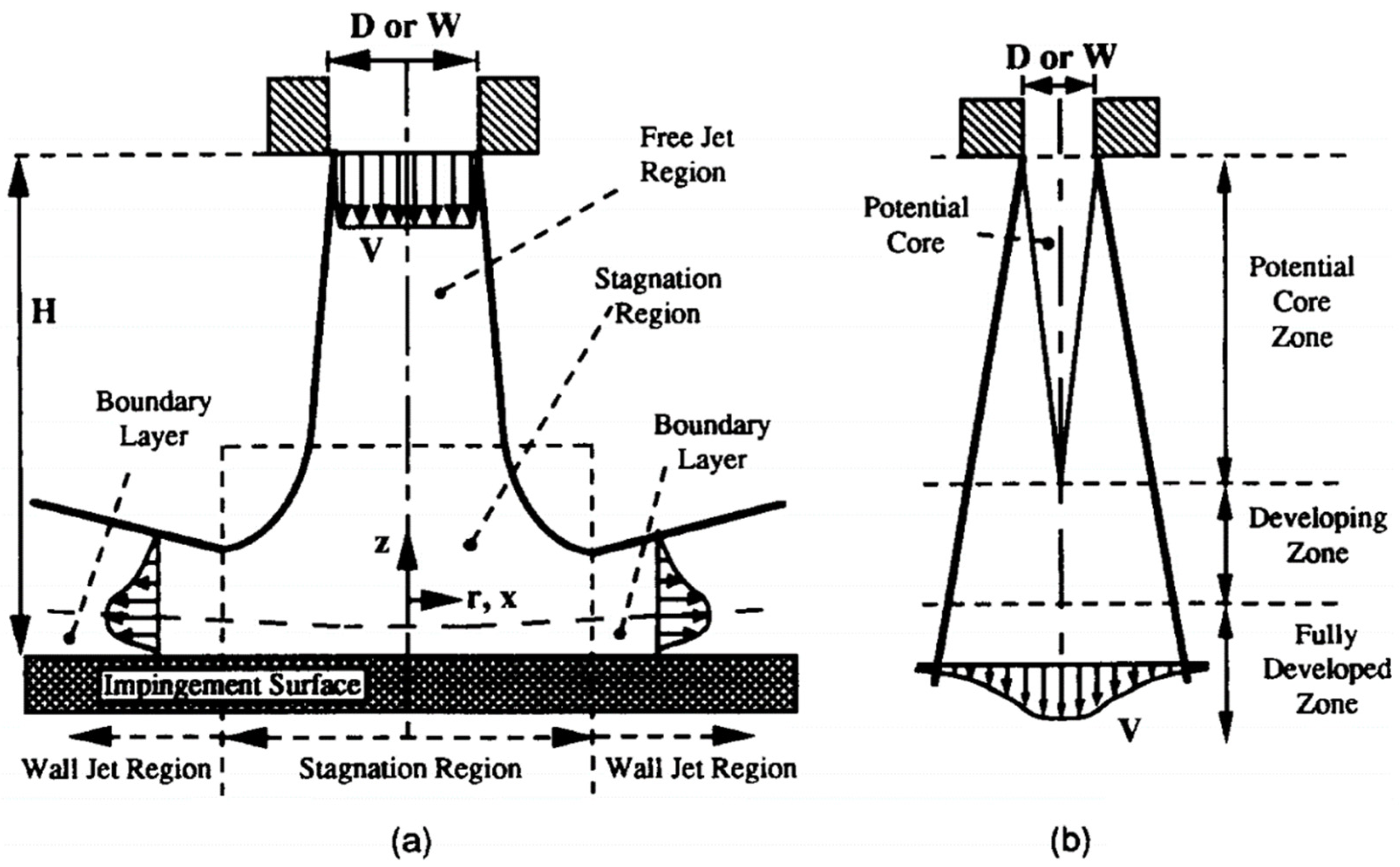

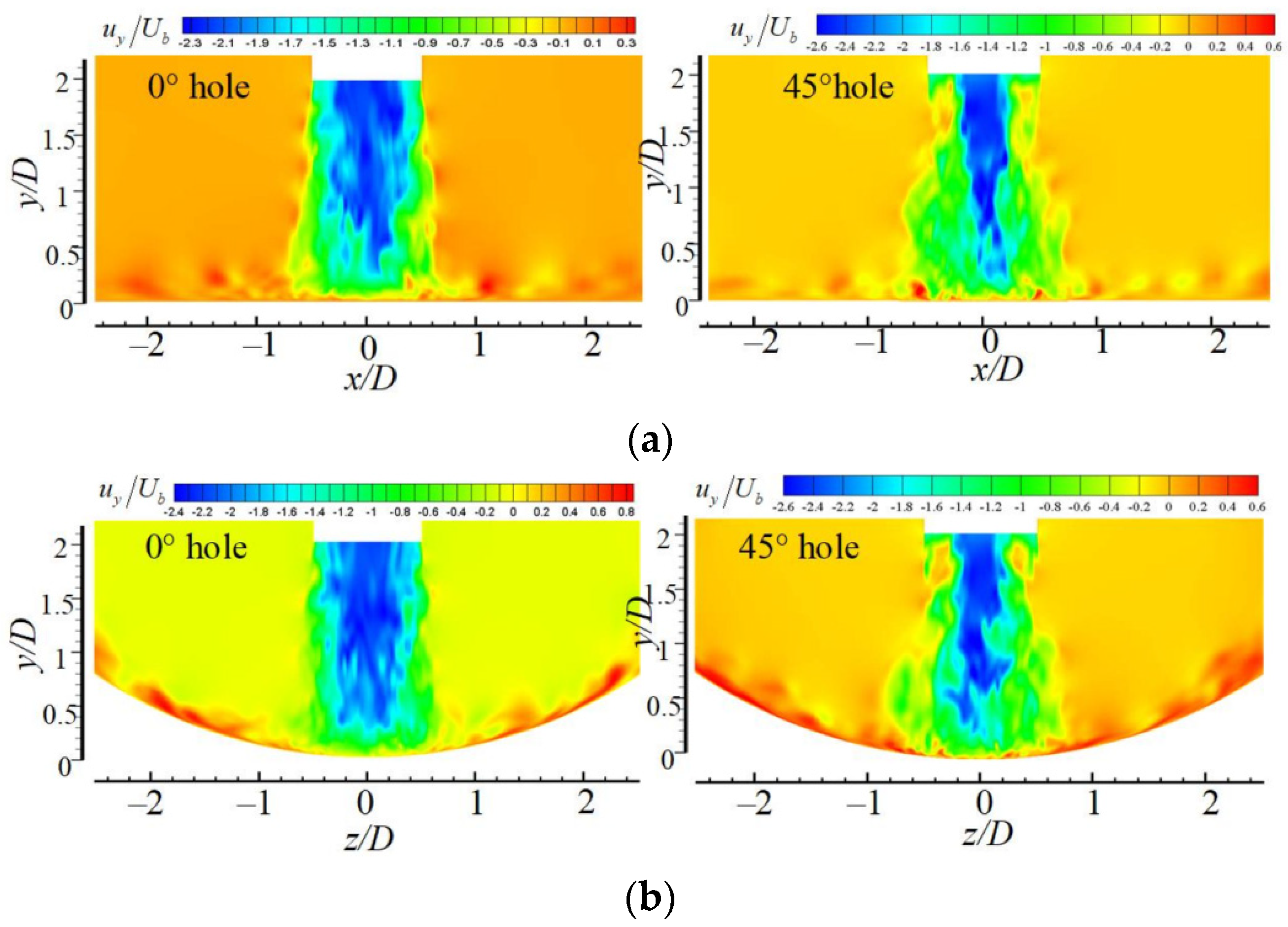
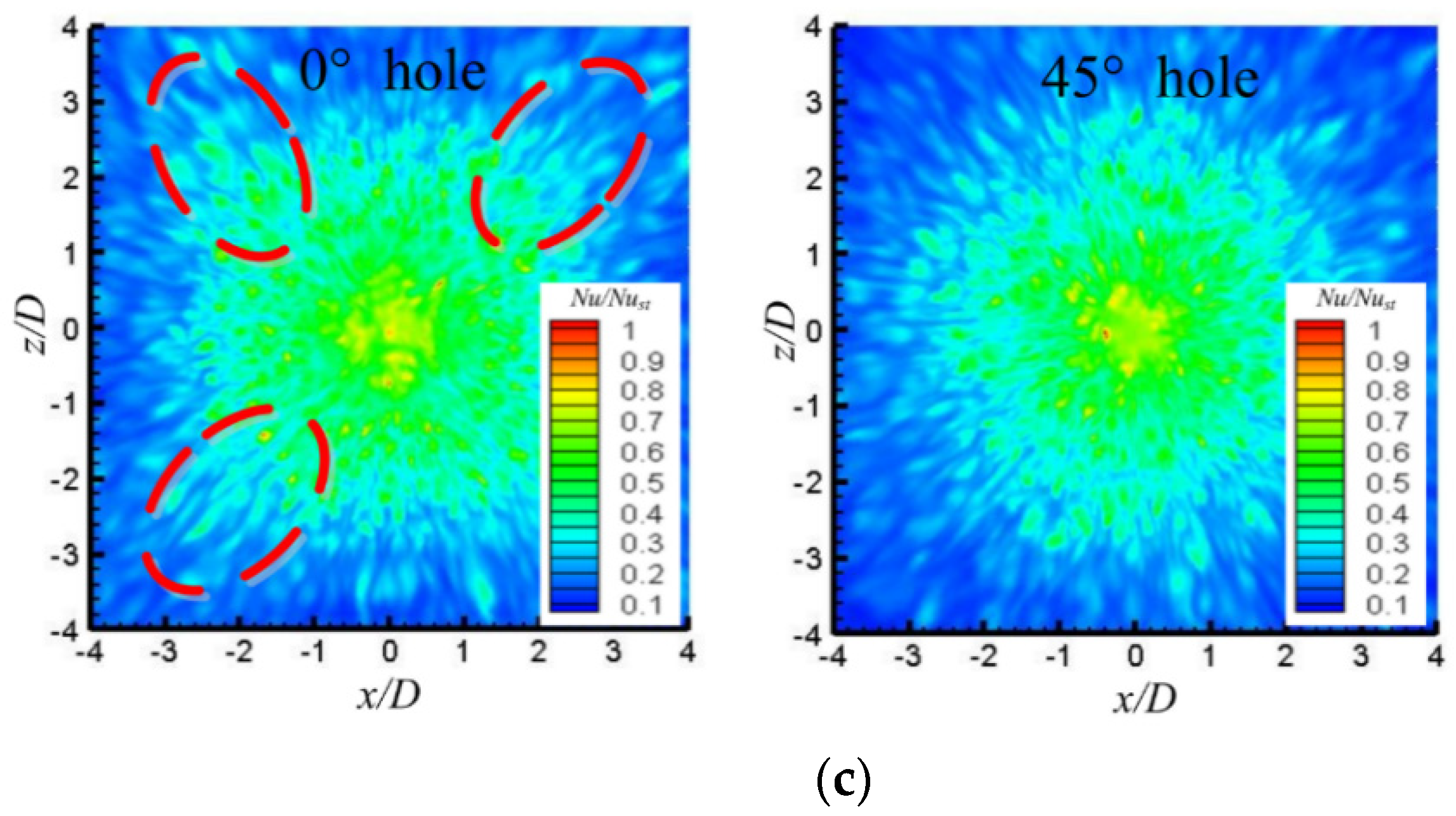


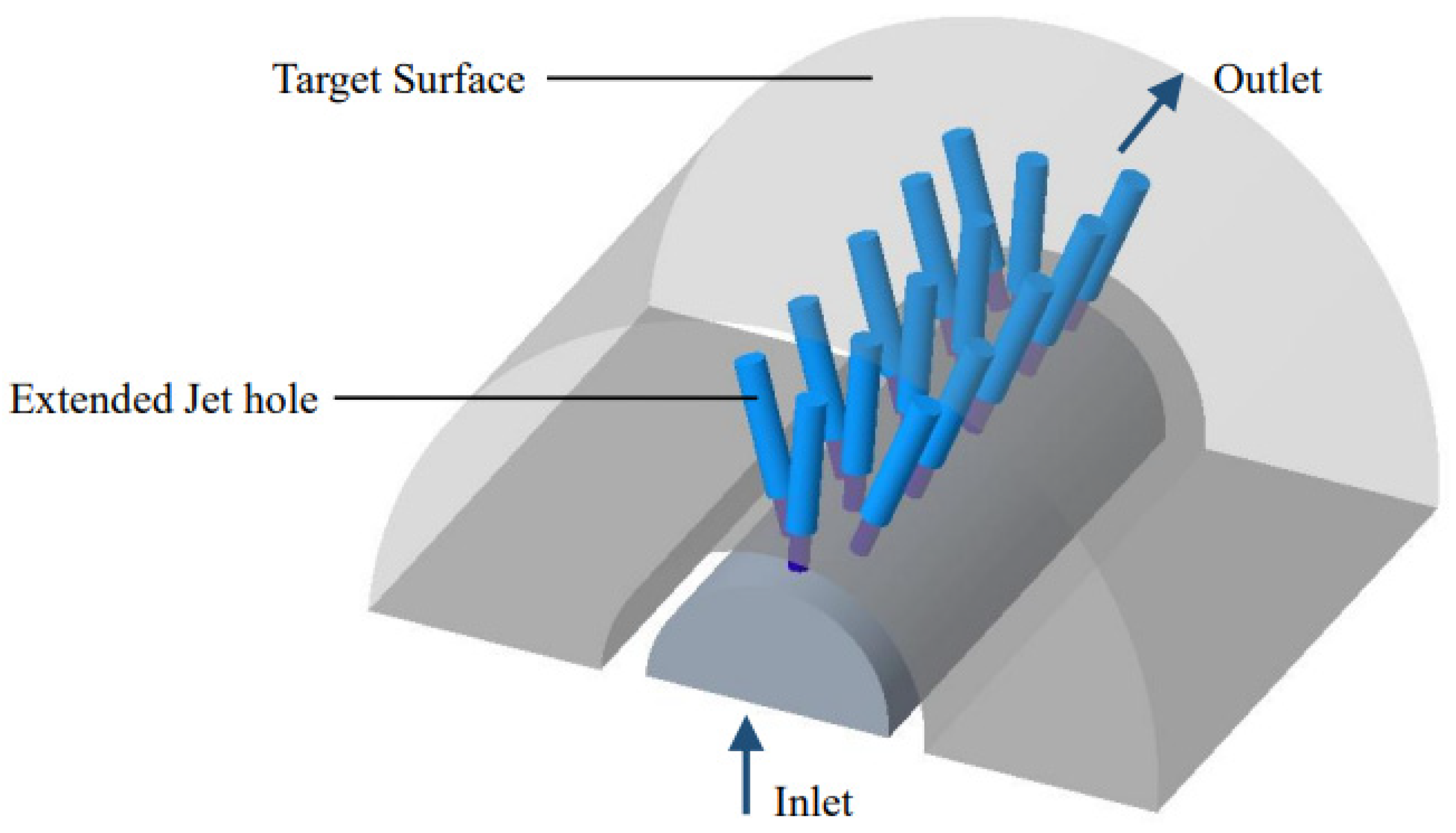
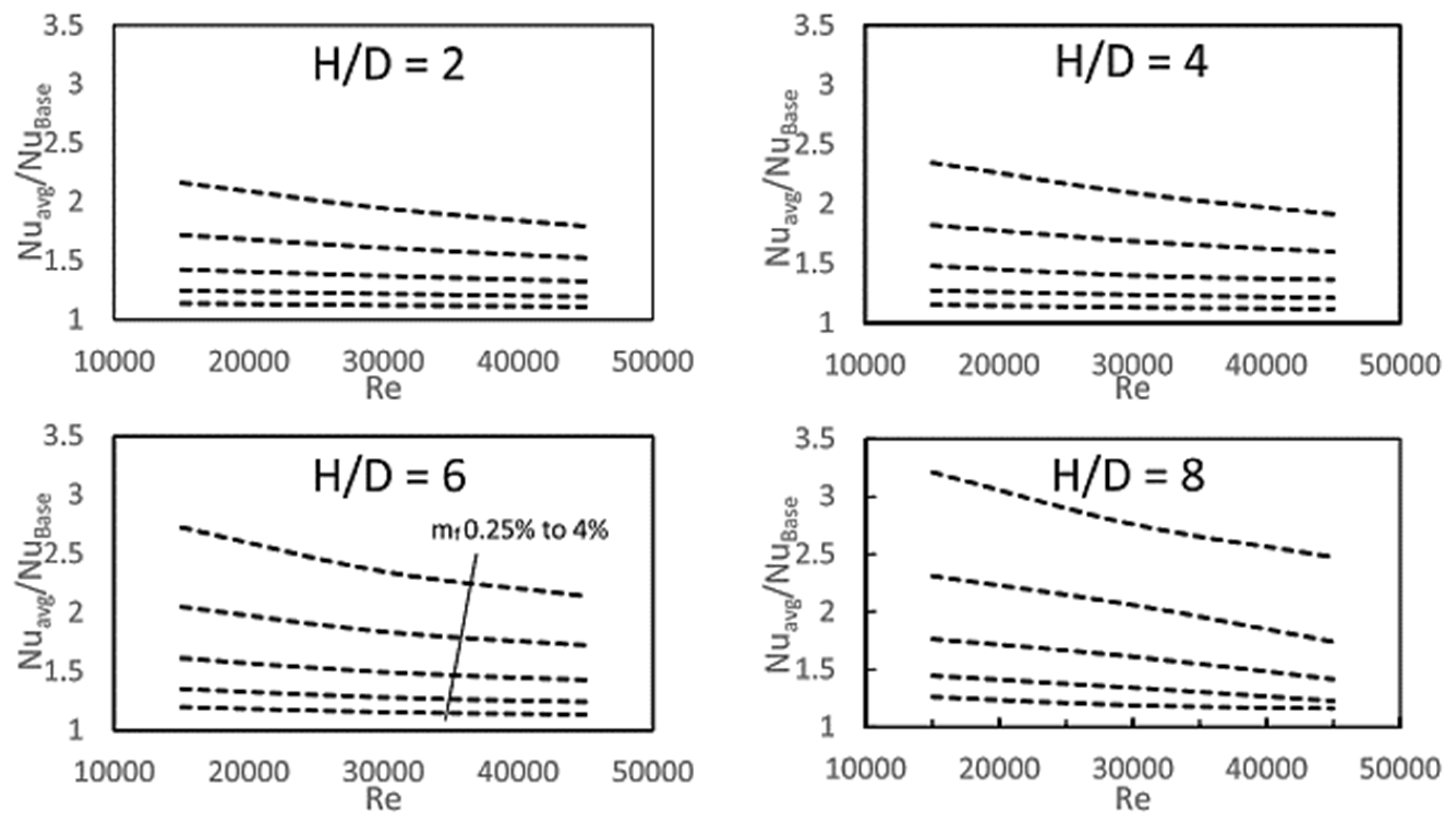
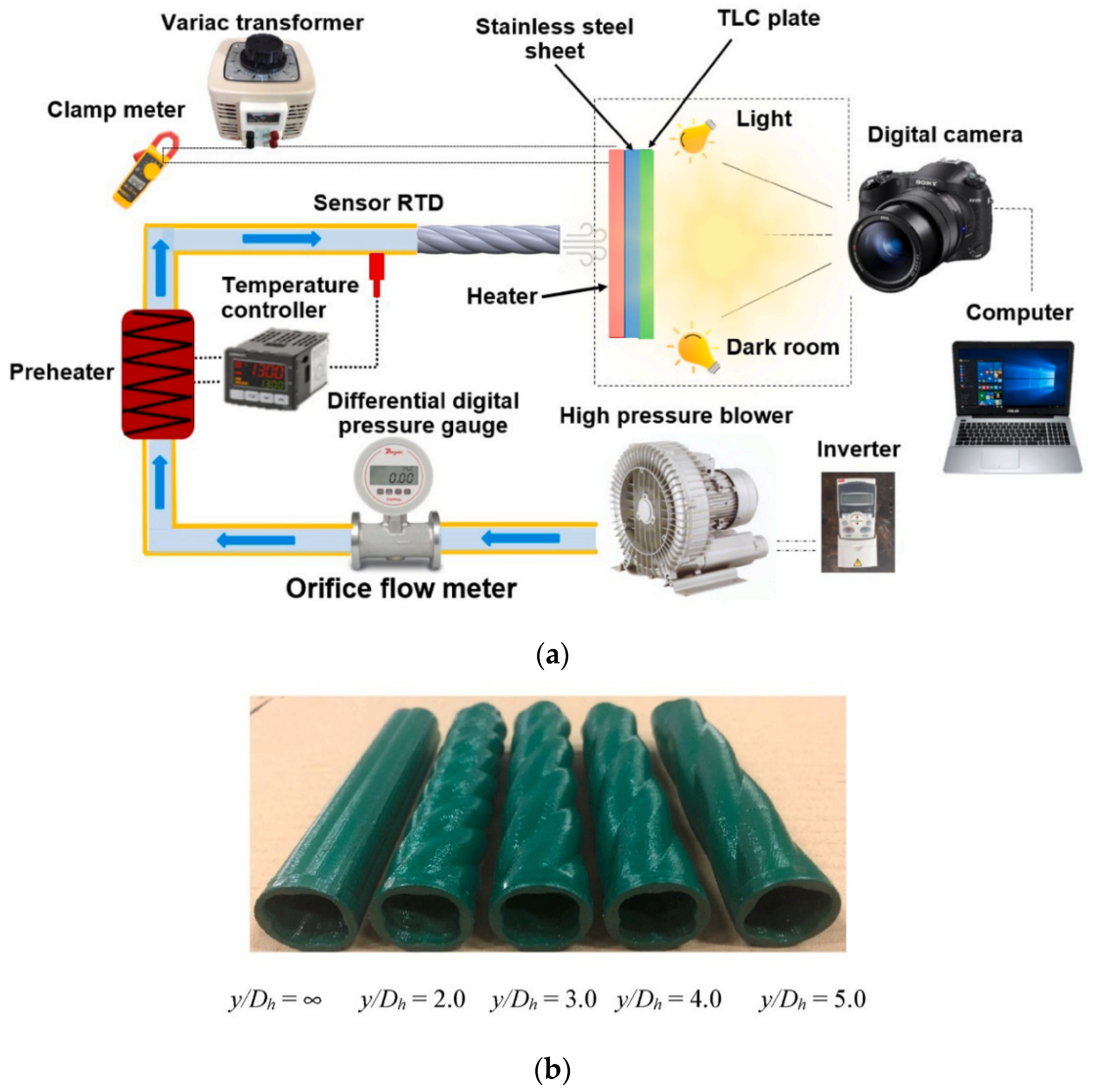
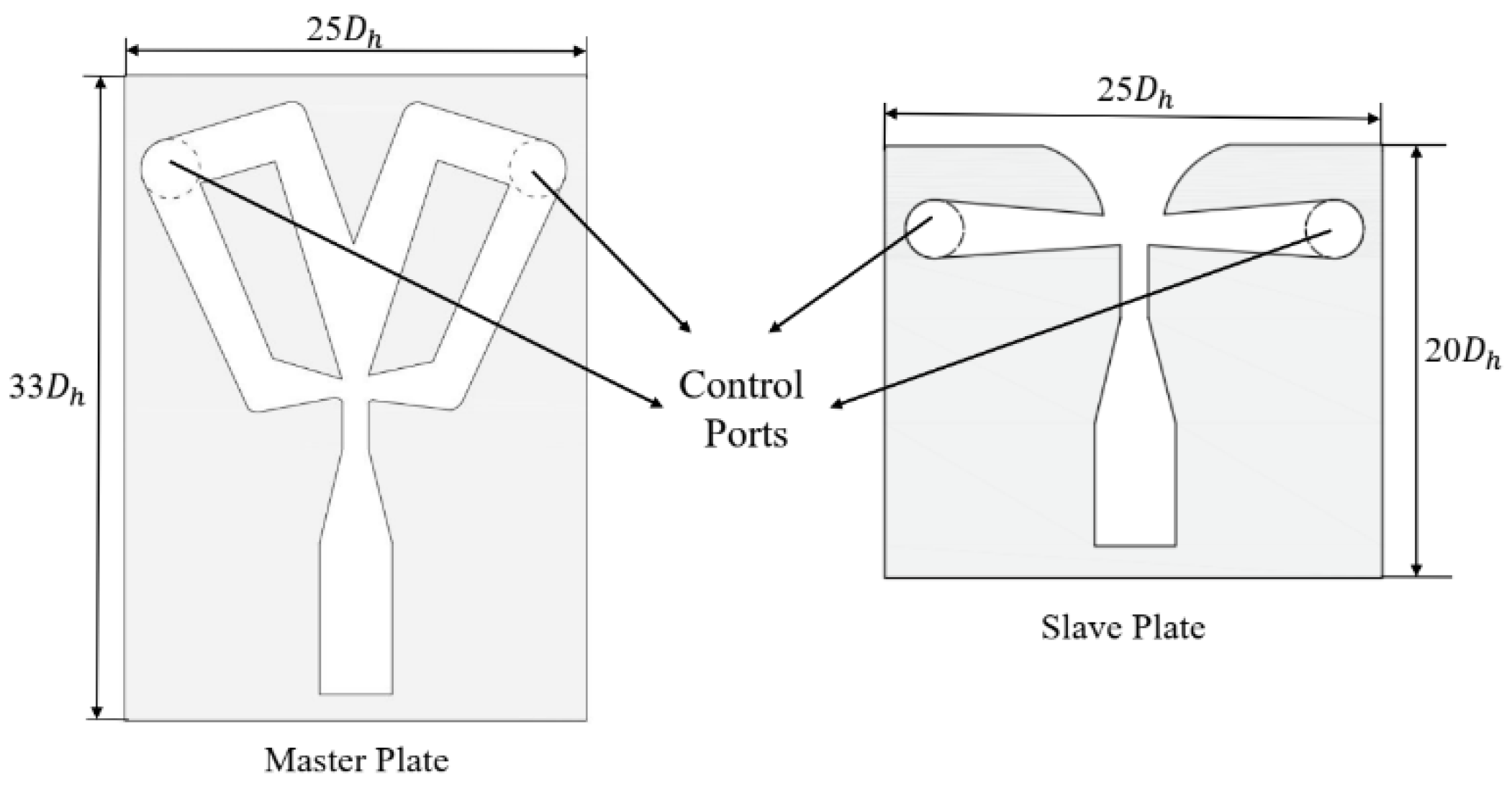

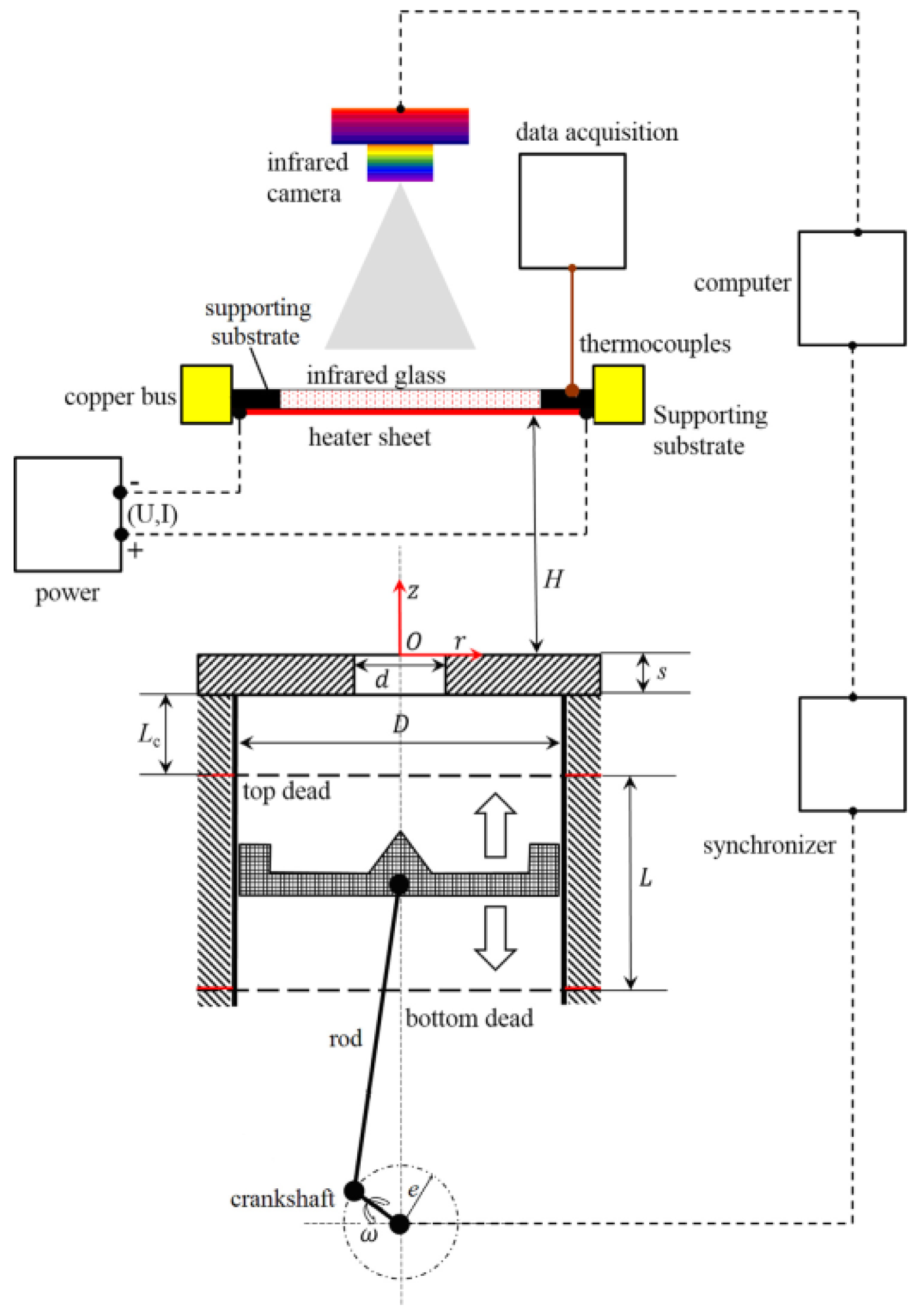
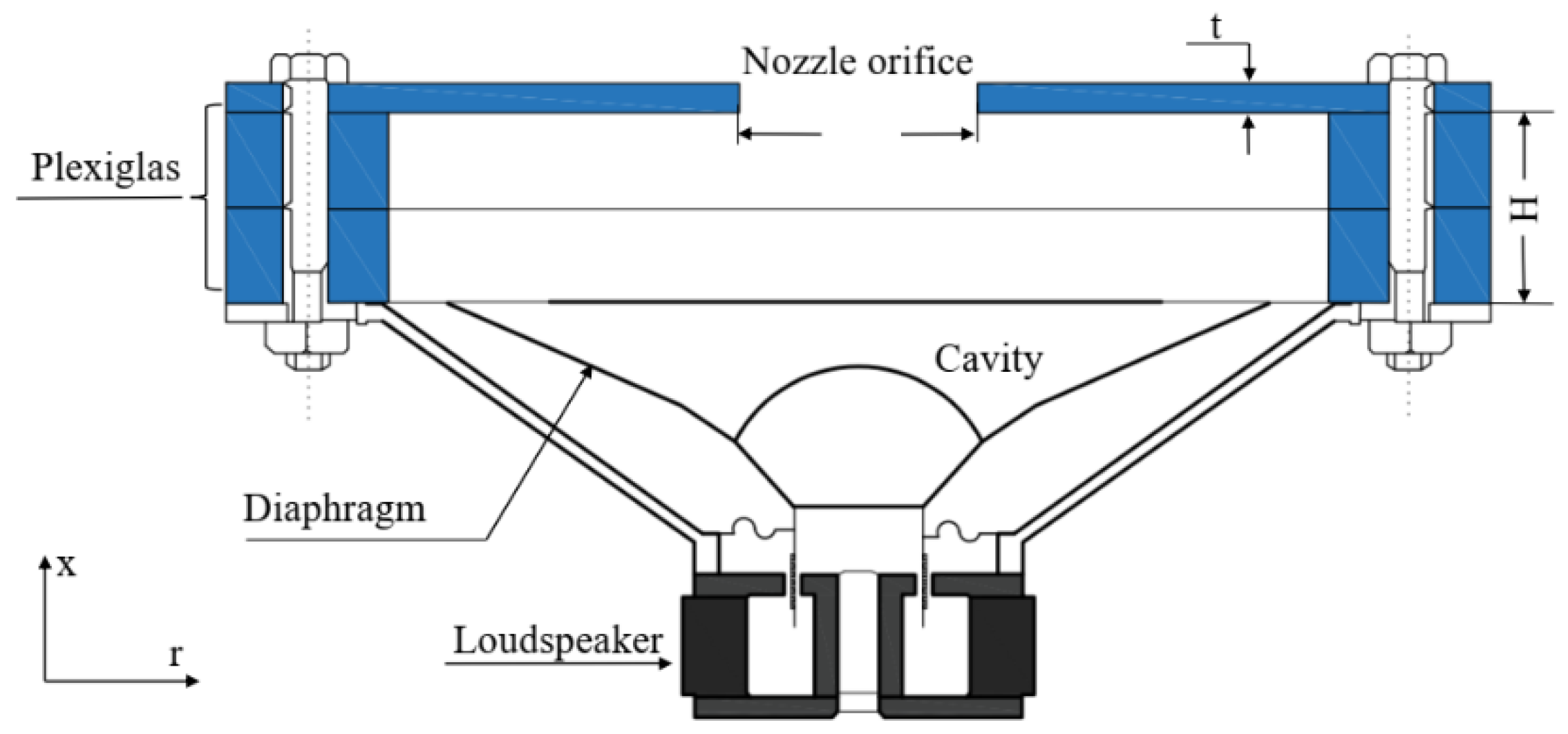
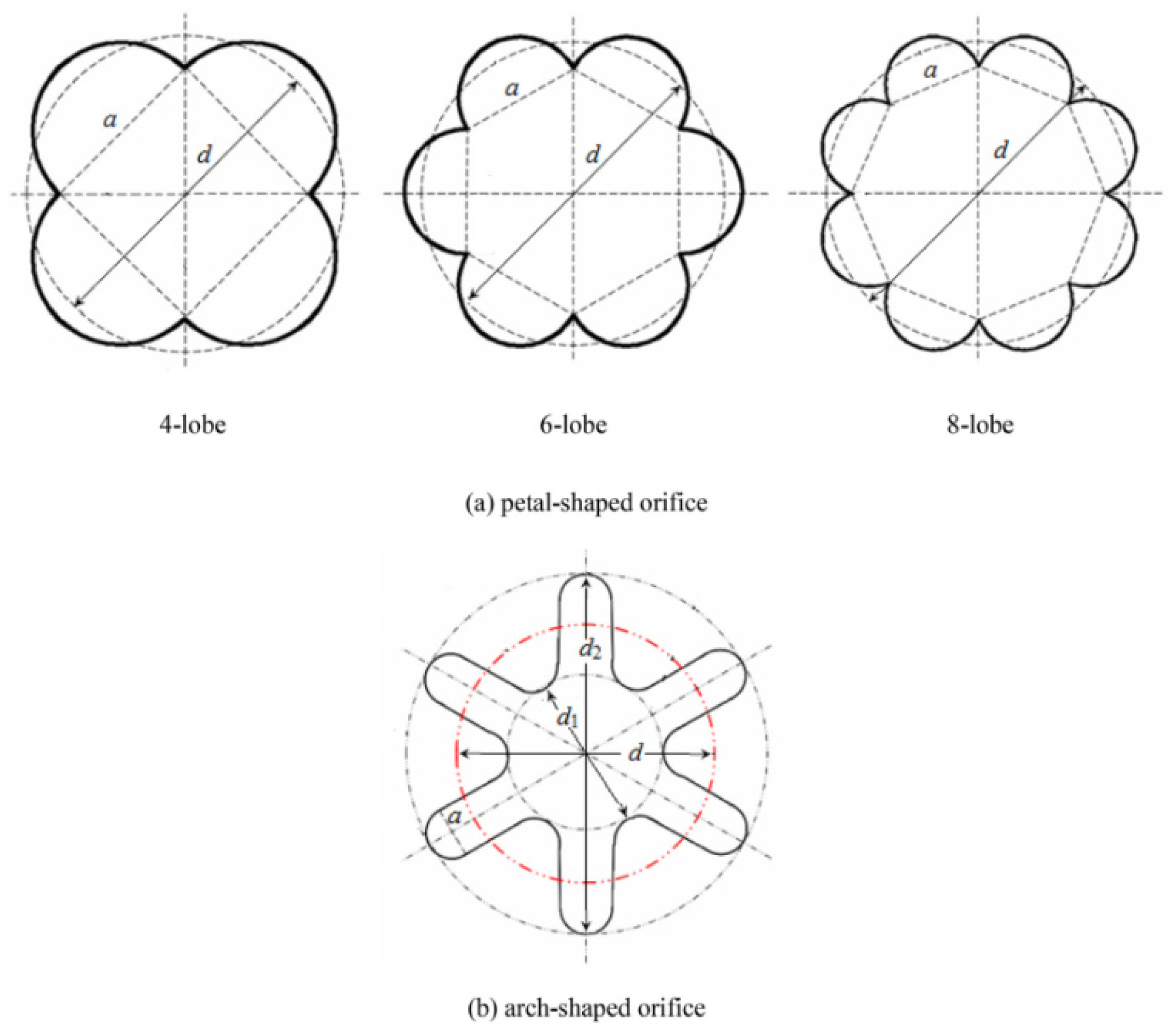

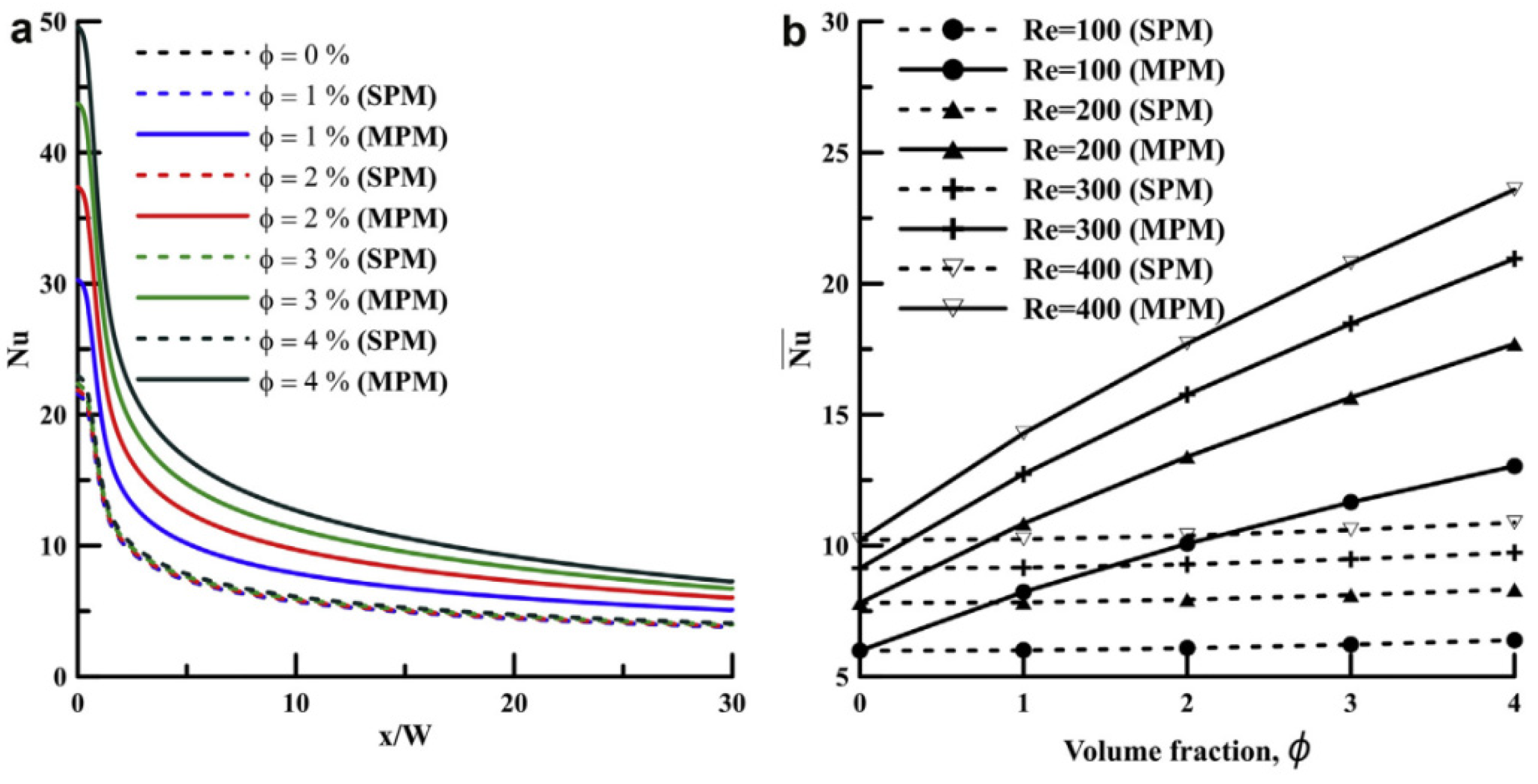
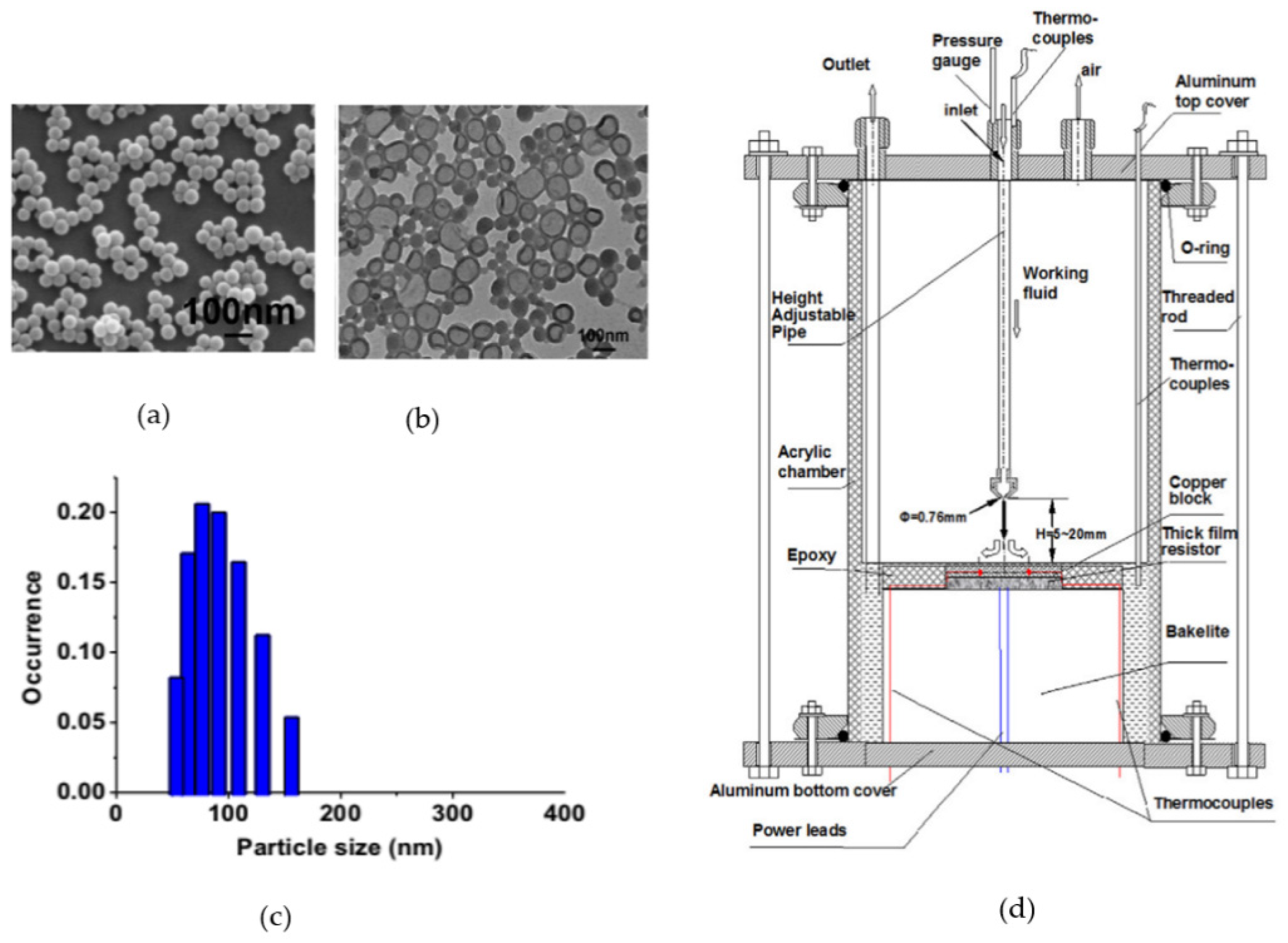
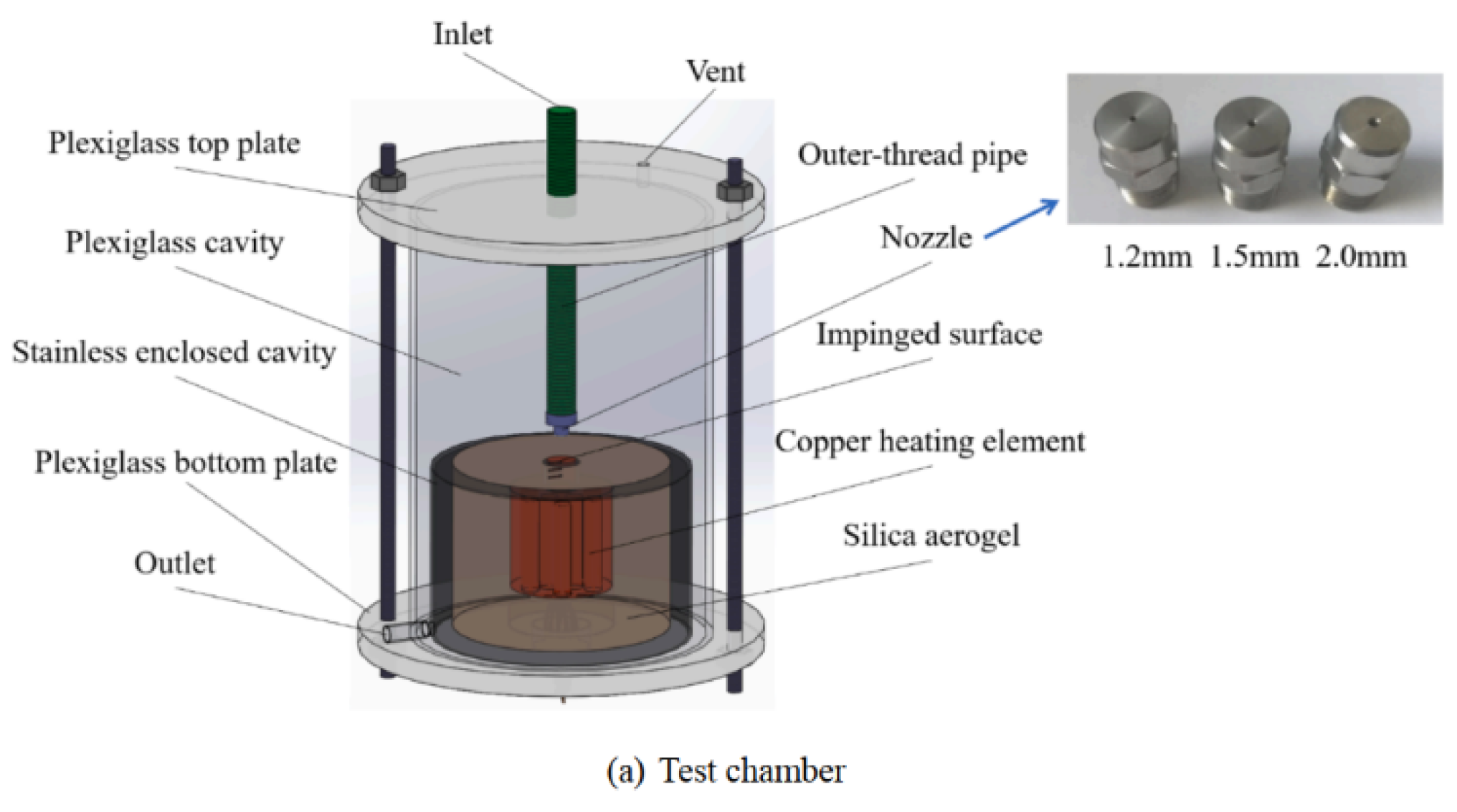
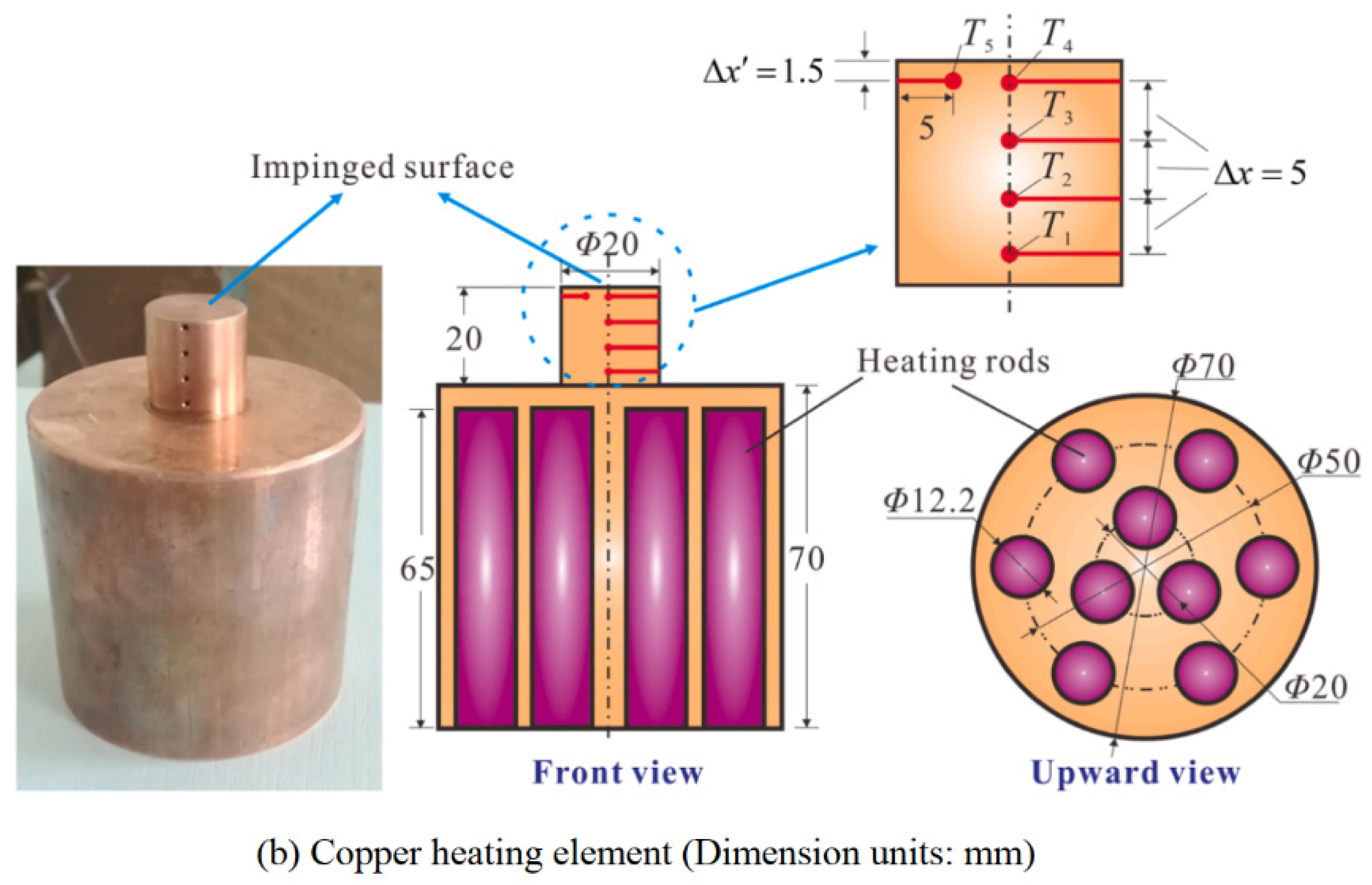
| Parameter | Purpose |
|---|---|
| Reynolds number | It is a ratio of inertial forces to viscous forces. It helps to assess turbulence effects by relating the jet velocity and nozzle diameter to the kinematic viscosity of the fluid. |
| Nusselt number | It is a ratio of convection–conduction heat transfer. It helps to quantify the thermal enhancement of a jet impinging method. |
| Prandtl number | It is a ratio of momentum diffusivity to thermal diffusivity. It accounts for the effect of hydrodynamic and thermal boundary layers for different types of impinging fluids. |
| Jet–target surface distance ratio | It is the spacing between jet plate and target surface. The stagnation zone and fluid–surface interactions of the impinging jets depend on the jet nozzle–target surface distance. |
| Jet–jet spacing | The spacing between adjacent jets. This is an important parameter to account for jet-to-jet interactions in thermal-hydraulic performance improvement of the target surface. |
| Ref. | Target Surface Shape | Variable Parameters | Key Remarks | Figure of Target Surface |
|---|---|---|---|---|
| McInturff et al. [48] | Triangular | Re = 900, 1500, 5000, and 11,000. Three jet array impingement hole shapes, i.e., circular, racetrack, and triangular, are used. | Addition of triangular roughness increases the heat transfer rate. | 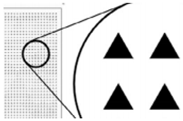 Reprinted with permission [48], Copyright 2018, Elsevier. |
| Singh and Ekkad [49] | V-shaped ribs and cylindrical dimples | Re = 19,500–69,000. Ratio of rib height to diameter = 0.125. Ratio of rib pitch to rib height = 16. Ratio of dimple depth to print diameter = 0.3 | The combined case of ribs and dimples gave better heat transfer and thermal-hydraulic performance as compared to ribs alone and dimples alone. |  Reprinted with permission [49], Copyright 2017, Elsevier. |
| Singh and Ekkad [50] | Dimple | Re = 2500. Rotational speed = 400 rpm. | For non-rotating conditions, heat transfer was enhanced for the dimpled surface. |  Adopted from [50]. |
| Vinze et al. [51] | Dimple | Pitch, p = 3 d, 4 d, and 5 d. Dimple depth = 0.25 d and 0.5 d. Orifice plate–test plate spacing = 1 d–6 d. | Pitch of 4d or higher improves heat transfer as compared to the flat surface. |  Adopted from [51]. |
| Singh and Prasad [52] | Concave | Chamfered and non-chamfered jet impingement configuration with constant pump power. H/d = 3, 5, 7, and 9. Re = 15,441–37,457. | 8% to 24% increase in the thermal performance factor and mild impact of jet–plate spacing. | 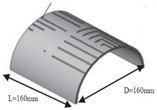 Reprinted with permission [52], Copyright 2018, Elsevier. |
| Jordan et al. [53] | Concave | Hole shapes: (i) cylindrical with Reynolds number = 13,600, 27,200, and 40,700 and (ii) racetrack shaped with Reynolds number = 11,500, 23,000, and 34,600. | A direct relation of Nu with the Reynolds number for both hole shapes was reported. The racetrack shape showed better heat transfer performance. |  Adopted from [53]. |
| Qiu et al. [54] | Concave | The jet arrangement was varied. Re = 10,000–40,000. Jet–target spacing = 1. Relative surface curvature = 10. | The performance of local heat transfer and fluid flow was analyzed. Better uniformity of heat transfer was reported. | 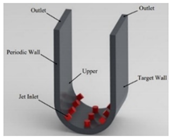 Adopted from [54]. |
| Takeishi et al. [55] | Circular | Re = 10,000. H/D = 3.0. Circular ring height = 0.58, 0.98, and 1.42. | 21% increase in the averaged area Nu for the circular ribs roughened surface. | 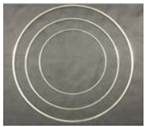 Reprinted with permission [55], Copyright 2020 MDPI. |
| Pachpute and Premacha-ndran [56] | Circular Cylinder | Re = 4500–20,000. Spacing between nozzle and target surface, H, and slot jet width, S, ratio, H/S = 2–10. D/S = 1, 2, and 4. | The cooling rate was reduced by 25% by the confinement wall. Impact of the confinement wall is significant only for H/S equal to or less than 4. |  Reprinted with permission from [56], Copyright 2018, Elsevier. |
| Pachpute and Premachandran [57] | Circular cylinder | Re = 5000–20,000. H/D = 2–12. | The average heat transfer was enhanced by 14% for H/D = 2 and Re = 20,000 for the staggered jet vs. inline jet arrangement. |  Adopted from [57]. |
| Ref. | Methodology | Key Findings |
|---|---|---|
| Zhang et al. [77] | • Numerical study to investigate the flow and heat transfer characteristics of jet impingement on a target surface containing a protrusion. | • Flow structures of the jet were found to be insensitive to the protrusion’s relative depth and the Reynolds number of the jet. • The jet turned its flow direction after it impinged perpendicularly on the protrusion, while flow separation and secondary impinging jet formation occurred when flow passed through the region of the protrusion edge. • An increase in the local Nu was observed in the case of the protrusion as compared to the smooth target surface. • As the protrusion’s relative depth increased, it caused an increase in the local Nu and the overall heat transfer was observed to increase for most of the cases due to an increase in the heat transfer area and enhancement of heat transfer in the stagnation region. |
| Selimefendigil and Öztop [78] | • Numerical study by impinging a jet over a partly curved surface with a CuO–water nanofluid. • Simulations were performed for Re = 100–500 and various solid particle volume fractions. | • A more pronounced effect over heat transfer and distribution of fluid flow was observed for the curved surface as compared to the flat one. • The average Nu increased linearly with the nanoparticle volume fraction, and a 20% enhancement in the average Nu was observed at the highest volume fraction. the |
| Wongcharee et al. [79] | • Experimental study of the impact of three different jet–plate spacing–nozzle diameter ratios (H/d), 2, 3, and 4, over jet impingement cooling. | • A decrease in Nu was experienced with the increase in the jet–plate spacing–nozzle diameter ratios (H/d). • The poor heat transfer at a high jet–plate spacing–nozzle diameter ratios (H/d) was observed to be caused by the impinging jet of lower intensity having a lower momentum on the target plate. |
| Feng et al. [80] | • Experimental and numerical study for five different nozzle–target plate distance values of H/D = 2, 4, 6, 8, and 10. | • It was observed from the results that at a low value of H/Dm the heat transfer rate is enhanced as more fluid is provided for cooling. |
| Sundaram et al. [81] | • Experimental and numerical investigation of heat transfer performance and pin-fin effectiveness of array jet impingement over a target surface having a roughness element of short height. • Array of 5 × 5 jets had a jet–jet spacing (X/D = Y/D) of 3 and a jet–target spacing (Z/D) of 1. | • Pin-fin effectiveness significantly increased, and it was observed that the height of the roughness element (H) is the dominant factor affecting heat transfer. • Effectiveness ranging between 1.8 and 2.4 was reported for the plate configurations used in this study, and the highest effectiveness was achieved by the configuration having the highest void fraction and wetted surface area. |
| Sagot et al. [82] | • Numerical and experimental investigation of air jet impingement on a flat surface for various jet–target surface spacings (H/D = 2–6). | • A Nu correlation was proposed for constant wall temperature conditions. • Lower values of Nu were obtained for the constant wall temperature in comparison with uniform heat flux. |
| Li et al. [83] | • Heat transfer performance of an impinging jet array arrangement was studied experimentally for jet–target surface spacing Z/D = 0.75–3, and yjr hole inclination angle was varied from 0° to 40°. | • An increase in Nu was observed with an increase in spacing between the jet and the target surface, and the peak value was reported at Z/D = 2. • The hole inclination angle was insensitive to the area-averaged Nu; however, a small impact over the local heat transfer distribution was reported. |
| Ansu et al. [84] | • An experimental investigation to study heat transfer performance over an unheated flat plate by impingement of a single jet and a row of jets for the jet–target surface spacing (L/D) of 2, 4, and 6. • The study was performed for Reynolds number values of 5000, 10,000, and 15,000. | • A decrease in the stagnation Nu was observed for an increasing L/D value up to 4, and a decreasing trend was reported afterward until L/D = 6 for all Re values in the single-nozzle case. • For the single-orifice case, a higher stagnation Nu value was observed for lower values of L/D. • For the nozzle case, the separation distance L/D = 4 gave optimum extraction of heat from the target surface for both a single and a row of jets. |
| Greco et al. [85] | • An experimental study was conducted to analyze the impact of the nozzle–target plate spacing H/D between 2 and 10 and for a fixed Reynolds number of 5250. | • Heat transfer fluctuations showed a decreasing trend with an increase in the nozzle–target plate distance H/D. • The maximum value of time-averaged stagnation Nu was observed at values between 4 and 6 for the jet–target plate spacing H/D. |
| Glaspell et al. [86] | • An experimental investigation was performed to study the impact of the nozzle–target surface distance for a range of H/d = 0.02–0.51. | • It was observed from the results that a decrease in the nozzle–target surface spacing causes an increase in the normalized stagnation Nu and hydraulic jump diameter. |
| Markal et al. [87] | • A coaxial air impinging jet having an outer conical outlet and an inner circular outlet was studied experimentally to investigate heat transfer performance at nozzle exit–target surface distance H/D = 0.5–6 and cone angles of 0°, 10°, 20°, and 30°. | • It was observed from the results that lower values of the distance between nozzle exit and target surface results in higher values of the local Nu, and the highest thermal performance was achieved for H/D = 2 or lower nozzle–target distances with cone angle 20°. |
| Chen et al. [88] | • Experimental study to investigate heat transfer performance for a combined effect of detached ribs and V ribs on a target plate and an impingement plate, respectively. • The investigation was performed for the separation distance H/D ranging from 3 to 5 and Re = 15,000 to 35,000. | • A higher area-averaged ratio of Nu for the Vi-detached rib case and the smooth case was obtained for H/D = 5 and Reynolds number = 35,000. • For all cases of the Vi-detached rib, the Nu value was higher as compared to the Nu obtained for the smooth case, and the aerodynamic effects were observed to be the cause of the increase in heat transfer. |
| Ref. | Type of Study | Type of Jet Excitation | Key Findings |
|---|---|---|---|
| Ahmed et al. [117] | Experimental/Numerical | Passive/Swirling | • The convective heat transfer for swirling jet impingement was found to be highest in the near field (low jet impingement distance), whereas for the far field (high jet impingent distance), the highest convective heat transfer was observed for the non-swirling jet. • In only the strong swirling jet case, stable recirculation zones (which affect the heat transfer coefficient) appeared on the impinged surface for near-field impingement. |
| Wu et al. [118] | Numerical | Passive/Swirling | • High local and uniform heat transfer regions were achieved through the combined effect of impingement and swirl cooling (swirl and impingement composite cooling). • The composite swirl impingement case achieved a 19.12% higher global average Nu as compared to the impingement-only case and a 4.29% lower pressure loss as compared to the swirl-only case. |
| Markal et al. [119] | Experimental | Passive/Swirling | • An enhancement in heat transfer was observed for coaxial swirling air impinging jets with an increase in the flow rate and a decrease in jet–target spacing. • The magnitude of the local Nu increased by 17% when the flow rate was increased from 40 LPM to 50 LPM. • A 10.6% and 29.7% increase in the average Nu was achieved through reducing the impingement distance and increasing the flow rate, respectively. |
| Singh and Chander [120] | Experimental/Numerical | Passive/Swirling | • Co swirling adjacent jets caused strong interaction, which resulted in high turbulence and mixing, and thus high heat transfer rates were obtained. • The effect of jet–jet spacing was observed to be more significant as compared to the jet–target surface distance. |
| Hossain et al. [121] | Experimental/Numerical | Passive/Sweeping | • The fluidic oscillator caused significantly improved cooling effectiveness due to its sweeping action in the sweeping jet cooling hole. • An improvement in overall cooling performance of the sweeping jet was observed at low blowing ratios. |
| Kim et al. [122] | Experimental | Passive/Sweeping | • A significantly higher heat transfer performance due to enhanced thermal transport near the impingement surface was achieved by the motion of the sweeping jet as compared to a steady square jet. •A drastic decrease in the heat transfer performance of sweeping jets was observed at higher jet–wall distances because of a reduction in impinging velocities. |
| Kim et al. [123] | Experimental | Passive/Sweeping | • It was observed during the results that the sweeping jet enhances the heat transfer rate for a concave target surface as compared to a flat surface. • The curvature magnitude resulted in peaks of Nu at moderate curvature, but no monotonic increase in Nu was observed otherwise. |
| Agrawal et al. [124] | Experimental | Passive/Annular | • The results showed that using an axis-symmetric nozzle, the rewetting temperature increased by an increase in the initial temperature of the surface and an increase in wetting delay, but a reduction in rewetting velocity was also reported. |
| Khangem-bam and Singh [125] | Experimental | Passive/Annular | • For a mist loading fraction range of 0.25–1.0%, an enhancement in the heat transfer coefficient at the stagnation point in the range of 185% to 312% was observed for the air–water mist impinging jet over the cylinder. |
| Khangem-bam et al. [126] | Experimental/Numerical | Passive/Annular | • A significant enhancement in heat transfer was reported with the increased mist loading fraction. • A high heat transfer enhancement of 408% and 775% at the stagnation point on the cylindrical surface was reported during the experimental and numerical study. |
| Guan et al. [127] | Experimental | Active/Synthetic | • The results reported an improvement in the effectiveness of heating for a chevron jet on a conical wall’s leading edge for small Reynolds number values. • A 20% enhancement in area average heating effectiveness was observed for the chevron nozzle jet in comparison to the conventional nozzle jet. |
| Guan et al. [128] | Numerical | Active/Synthetic | • Heat transfer performance improved by a chevron nozzle in the vicinity of the leading edge of the conical wall by causing high jet fluctuations through an increase in the jet core velocity. • For a constant chevron length ratio, the average heating effectiveness increased with an increase in the chevron penetration depth ratio. |
| Li et al. [129] | Numerical | Active/Synthetic | • For all the Reynolds number values used in the study, the corresponding interval of the Strouhal number was reported to be 0.24–0.48 for the maximum average Nu. • The trend of the amplitude and variation of the average Nu was reported to be significantly influenced by the Reynolds number or forcing frequency of the synthetic jet. |
| Hsu et al. [130] | Experimental | Active/Pulsating | • Convective heat transfer was reported to be enhanced by increasing the axial convective velocity of the ring generated by the vortex and fluctuation intensity. |
| Rakhsha et al. [131] | Experimental/Numerical | Active/Pulsating | • In comparison to steady jets, heat transfer enhancements of 21%, 30%, and 36% were reported for pulsating jet frequencies of 50, 80, and 100 Hz, respectively, at jet–target surface distance (H/d) = 5 and Re = 10,000. • An increase in Nu was observed with an increase in the pulsating frequency and Reynolds number, while a reduction in Nu was reported with increasing spacing between jet and target surface. |
| Ref. | Study | Nanofluid | Flow Rate/Reynolds Number | Heat Transfer Performance |
|---|---|---|---|---|
| Selimefendigil and Öztop [147] | Numerical | Al2O3–water | 100–400 | Average heat transfer enhanced by 46% |
| Sun et al. [148] | Experimental | Silver–multiwall carbon nanotube (Ag-MWCNT)/water hybrid nanofluids | 0.1–0.6 m3·h−1 | Heat transfer coefficient enhanced by 29.45% |
| Sorour et al. [149] | Experimental | SiO2–water | 40,000 | Nu increased up to 80% |
| Kareem et al. [150] | Experimental/Numerical | CuO–water | 1000–8000 | 2.9% maximum enhancement in Nu |
| Amjadian et al. [151] | Experimental | Cu2O–water | 7330–11,082 | Convective heat transfer enhanced by 45.7% |
| Allauddin et al. [152] | Numerical | Al2O3–water | 4000–20,000 | Heat transfer coefficient improved by 72% |
| Balla et al. [153] | Experimental | Zn–water | 200–1000 | Nu enhanced by 2.1% |
| Al-Zuhairy et al. [154] | Experimental | Al2O3–water | 400–2000 | 200% increase in Nu |
| Sodagar-Abardeh et al. [155] | Numerical | Boehmite alumina–water and ethylene glycol mixture (50:50) | 100–400 | 83.3% increase in Nu |
| Balla et al. [156] | Experimental | ZnO–water | 5000–17,500 | 113.9% enhancement in Nu |
Publisher’s Note: MDPI stays neutral with regard to jurisdictional claims in published maps and institutional affiliations. |
© 2021 by the authors. Licensee MDPI, Basel, Switzerland. This article is an open access article distributed under the terms and conditions of the Creative Commons Attribution (CC BY) license (https://creativecommons.org/licenses/by/4.0/).
Share and Cite
Hussain, L.; Khan, M.M.; Masud, M.; Ahmed, F.; Rehman, Z.; Amanowicz, Ł.; Rajski, K. Heat Transfer Augmentation through Different Jet Impingement Techniques: A State-of-the-Art Review. Energies 2021, 14, 6458. https://doi.org/10.3390/en14206458
Hussain L, Khan MM, Masud M, Ahmed F, Rehman Z, Amanowicz Ł, Rajski K. Heat Transfer Augmentation through Different Jet Impingement Techniques: A State-of-the-Art Review. Energies. 2021; 14(20):6458. https://doi.org/10.3390/en14206458
Chicago/Turabian StyleHussain, Liaqat, Muhammad Mahabat Khan, Manzar Masud, Fawad Ahmed, Zabdur Rehman, Łukasz Amanowicz, and Krzysztof Rajski. 2021. "Heat Transfer Augmentation through Different Jet Impingement Techniques: A State-of-the-Art Review" Energies 14, no. 20: 6458. https://doi.org/10.3390/en14206458
APA StyleHussain, L., Khan, M. M., Masud, M., Ahmed, F., Rehman, Z., Amanowicz, Ł., & Rajski, K. (2021). Heat Transfer Augmentation through Different Jet Impingement Techniques: A State-of-the-Art Review. Energies, 14(20), 6458. https://doi.org/10.3390/en14206458








